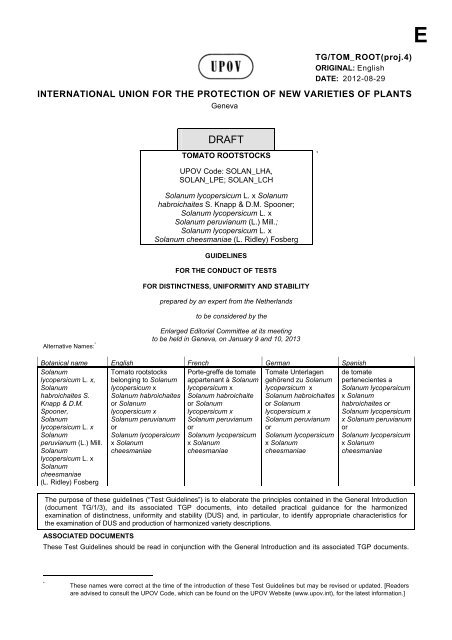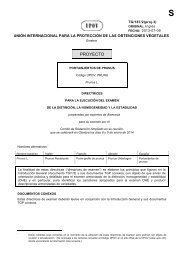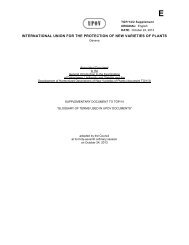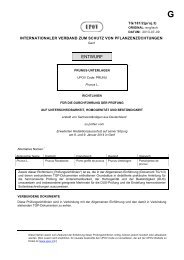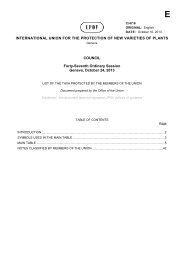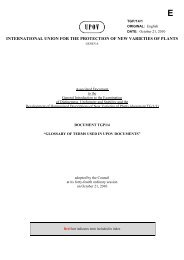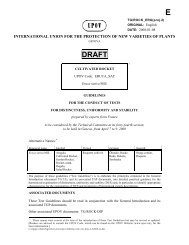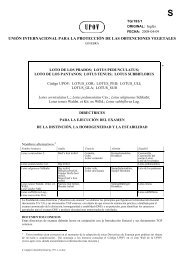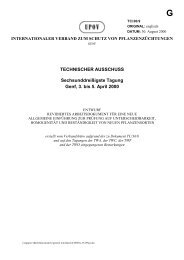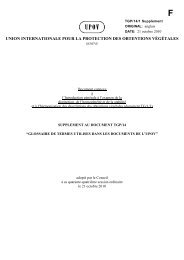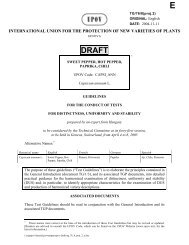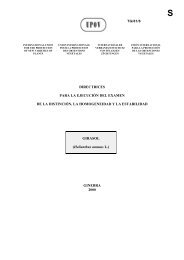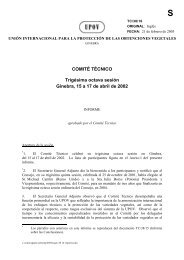E - International Union for the Protection of New Varieties of Plants
E - International Union for the Protection of New Varieties of Plants
E - International Union for the Protection of New Varieties of Plants
Create successful ePaper yourself
Turn your PDF publications into a flip-book with our unique Google optimized e-Paper software.
TG/TOM_ROOT(proj.4)<br />
ORIGINAL: English<br />
DATE: 2012-08-29<br />
INTERNATIONAL UNION FOR THE PROTECTION OF NEW VARIETIES OF PLANTS<br />
Geneva<br />
Alternative Names: *<br />
DRAFT<br />
TOMATO ROOTSTOCKS<br />
UPOV Code: SOLAN_LHA,<br />
SOLAN_LPE; SOLAN_LCH<br />
Solanum lycopersicum L. x Solanum<br />
habroichaites S. Knapp & D.M. Spooner;<br />
Solanum lycopersicum L. x<br />
Solanum peruvianum (L.) Mill.;<br />
Solanum lycopersicum L. x<br />
Solanum cheesmaniae (L. Ridley) Fosberg<br />
GUIDELINES<br />
FOR THE CONDUCT OF TESTS<br />
FOR DISTINCTNESS, UNIFORMITY AND STABILITY<br />
prepared by an expert from <strong>the</strong> Ne<strong>the</strong>rlands<br />
to be considered by <strong>the</strong><br />
Enlarged Editorial Committee at its meeting<br />
to be held in Geneva, on January 9 and 10, 2013<br />
Botanical name English French German Spanish<br />
Solanum<br />
lycopersicum L. x,<br />
Solanum<br />
habroichaites S.<br />
Knapp & D.M.<br />
Spooner,<br />
Solanum<br />
lycopersicum L. x<br />
Solanum<br />
peruvianum (L.) Mill.<br />
Solanum<br />
lycopersicum L. x<br />
Solanum<br />
cheesmaniae<br />
(L. Ridley) Fosberg<br />
Tomato rootstocks<br />
belonging to Solanum<br />
lycopersicum x<br />
Solanum habroichaites<br />
or Solanum<br />
lycopersicum x<br />
Solanum peruvianum<br />
or<br />
Solanum lycopersicum<br />
x Solanum<br />
cheesmaniae<br />
Porte-greffe de tomate<br />
appartenant à Solanum<br />
lycopersicum x<br />
Solanum habroichaite<br />
or Solanum<br />
lycopersicum x<br />
Solanum peruvianum<br />
or<br />
Solanum lycopersicum<br />
x Solanum<br />
cheesmaniae<br />
Tomate Unterlagen<br />
gehörend zu Solanum<br />
lycopersicum x<br />
Solanum habroichaites<br />
or Solanum<br />
lycopersicum x<br />
Solanum peruvianum<br />
or<br />
Solanum lycopersicum<br />
x Solanum<br />
cheesmaniae<br />
*<br />
de tomate<br />
pertenecientes a<br />
Solanum lycopersicum<br />
x Solanum<br />
habroichaites or<br />
Solanum lycopersicum<br />
x Solanum peruvianum<br />
or<br />
Solanum lycopersicum<br />
x Solanum<br />
cheesmaniae<br />
The purpose <strong>of</strong> <strong>the</strong>se guidelines (“Test Guidelines”) is to elaborate <strong>the</strong> principles contained in <strong>the</strong> General Introduction<br />
(document TG/1/3), and its associated TGP documents, into detailed practical guidance <strong>for</strong> <strong>the</strong> harmonized<br />
examination <strong>of</strong> distinctness, uni<strong>for</strong>mity and stability (DUS) and, in particular, to identify appropriate characteristics <strong>for</strong><br />
<strong>the</strong> examination <strong>of</strong> DUS and production <strong>of</strong> harmonized variety descriptions.<br />
ASSOCIATED DOCUMENTS<br />
These Test Guidelines should be read in conjunction with <strong>the</strong> General Introduction and its associated TGP documents.<br />
* These names were correct at <strong>the</strong> time <strong>of</strong> <strong>the</strong> introduction <strong>of</strong> <strong>the</strong>se Test Guidelines but may be revised or updated. [Readers<br />
are advised to consult <strong>the</strong> UPOV Code, which can be found on <strong>the</strong> UPOV Website (www.upov.int), <strong>for</strong> <strong>the</strong> latest in<strong>for</strong>mation.]<br />
E
TG/TOM_ROOT(proj.4)<br />
Tomato Rootstocks, 2012-08-29<br />
- 2 -<br />
TABLE OF CONTENTS PAGE<br />
1. SUBJECT OF THESE TEST GUIDELINES .................................................................................................................. 3<br />
2. MATERIAL REQUIRED................................................................................................................................................. 3<br />
3. METHOD OF EXAMINATION ....................................................................................................................................... 3<br />
3.1 NUMBER OF GROWING CYCLES ................................................................................................................................. 3<br />
3.2 TESTING PLACE ....................................................................................................................................................... 3<br />
3.3 CONDITIONS FOR CONDUCTING THE EXAMINATION ...................................................................................................... 3<br />
3.4 TEST DESIGN .......................................................................................................................................................... 3<br />
3.5 ADDITIONAL TESTS................................................................................................................................................... 4<br />
4. ASSESSMENT OF DISTINCTNESS, UNIFORMITY AND STABILITY ......................................................................... 4<br />
4.1 DISTINCTNESS ......................................................................................................................................................... 4<br />
4.2 UNIFORMITY ............................................................................................................................................................ 5<br />
4.3 STABILITY................................................................................................................................................................ 5<br />
5. GROUPING OF VARIETIES AND ORGANIZATION OF THE GROWING TRIAL......................................................... 5<br />
6. INTRODUCTION TO THE TABLE OF CHARACTERISTICS........................................................................................ 6<br />
6.1 CATEGORIES OF CHARACTERISTICS........................................................................................................................... 6<br />
6.2 STATES OF EXPRESSION AND CORRESPONDING NOTES............................................................................................... 6<br />
6.3 TYPES OF EXPRESSION ............................................................................................................................................ 6<br />
6.4 EXAMPLE VARIETIES ................................................................................................................................................ 6<br />
6.5 LEGEND .................................................................................................................................................................. 7<br />
7. TABLE OF CHARACTERISTICS/TABLEAU DES CARACTÈRES/MERKMALSTABELLE/TABLA DE<br />
CARACTERES.............................................................................................................................................................. 8<br />
8. EXPLANATIONS ON THE TABLE OF CHARACTERISTICS...................................................................................... 13<br />
8.1 EXPLANATIONS COVERING SEVERAL CHARACTERISTICS.............................................................................................. 13<br />
8.2 EXPLANATIONS FOR INDIVIDUAL CHARACTERISTICS .................................................................................................... 13<br />
9. LITERATURE .............................................................................................................................................................. 28<br />
10. TECHNICAL QUESTIONNAIRE.................................................................................................................................. 29
1. Subject <strong>of</strong> <strong>the</strong>se Test Guidelines<br />
TG/TOM_ROOT(proj.4)<br />
Tomato Rootstocks, 2012-08-29<br />
- 3 -<br />
1.1 These Test Guidelines apply to all varieties <strong>of</strong> Solanum lycopersicum L. x Solanum habroichaites S.<br />
Knapp & D.M. Spooner (Lycopersicum esculentum Mill. x Lycopersicum hirsutum Dunal.), Solanum<br />
lycopersicum L. x Solanum peruvianum L. (Mill.) and Solanum lycopersicum L. x Solanum cheesmaniae<br />
(L. Ridley) Fosberg. Such varieties are generally used as rootstocks <strong>for</strong> tomato varieties (varieties <strong>of</strong><br />
Solanum lycopersicum L. (Lycopersicum esculentum L. (Mill.)).<br />
1.2 Rootstocks belonging to Solanum lycopersicum L. (Lycopersicum esculentum Mill.) or to Solanum<br />
lycopersicum L. x Solanum pimpinellifolium L. (Lycopersicum esculentum Mill. x Lycopersicum<br />
pimpinellifolium Mill.) should be covered by UPOV Test Guidelines TG/44/11.<br />
2. Material Required<br />
2.1 The competent authorities decide on <strong>the</strong> quantity and quality <strong>of</strong> <strong>the</strong> plant material required <strong>for</strong> testing<br />
<strong>the</strong> variety and when and where it is to be delivered. Applicants submitting material from a State o<strong>the</strong>r than<br />
that in which <strong>the</strong> testing takes place must ensure that all customs <strong>for</strong>malities and phytosanitary requirements<br />
are complied with.<br />
2.2 The material is to be supplied in <strong>the</strong> <strong>for</strong>m <strong>of</strong> seed.<br />
2.3 The minimum quantity <strong>of</strong> plant material, to be supplied by <strong>the</strong> applicant, should be:<br />
10 g or 2,500 seeds.<br />
In <strong>the</strong> case <strong>of</strong> seed, <strong>the</strong> seed should meet <strong>the</strong> minimum requirements <strong>for</strong> germination, species and<br />
analytical purity, health and moisture content, specified by <strong>the</strong> competent authority.<br />
2.4 The plant material supplied should be visibly healthy, not lacking in vigor, nor affected by any<br />
important pest or disease.<br />
2.5 The plant material should not have undergone any treatment which would affect <strong>the</strong> expression <strong>of</strong><br />
<strong>the</strong> characteristics <strong>of</strong> <strong>the</strong> variety, unless <strong>the</strong> competent authorities allow or request such treatment. If it has<br />
been treated, full details <strong>of</strong> <strong>the</strong> treatment must be given.<br />
3. Method <strong>of</strong> Examination<br />
3.1 Number <strong>of</strong> Growing Cycles<br />
The minimum duration <strong>of</strong> tests should normally be two independent growing cycles.<br />
3.2 Testing Place<br />
Tests are normally conducted at one place. In <strong>the</strong> case <strong>of</strong> tests conducted at more than one place,<br />
guidance is provided in TGP/9 “Examining Distinctness”.<br />
3.3 Conditions <strong>for</strong> Conducting <strong>the</strong> Examination<br />
The tests should be carried out under conditions ensuring satisfactory growth <strong>for</strong> <strong>the</strong> expression <strong>of</strong><br />
<strong>the</strong> relevant characteristics <strong>of</strong> <strong>the</strong> variety and <strong>for</strong> <strong>the</strong> conduct <strong>of</strong> <strong>the</strong> examination.<br />
3.4 Test Design<br />
3.4.1 Each test should be designed to result in a total <strong>of</strong> at least 20 plants, which should be divided<br />
between at least two replicates.<br />
3.4.2 When resistance characteristics are used <strong>for</strong> assessing distinctness, uni<strong>for</strong>mity and stability, records<br />
must be taken under conditions <strong>of</strong> controlled infection and, unless o<strong>the</strong>rwise specified, on at least 20 plants.
TG/TOM_ROOT(proj.4)<br />
Tomato Rootstocks, 2012-08-29<br />
- 4 -<br />
3.4.3 The design <strong>of</strong> <strong>the</strong> tests should be such that plants or parts <strong>of</strong> plants may be removed <strong>for</strong><br />
measurement or counting without prejudice to <strong>the</strong> observations which must be made up to <strong>the</strong> end <strong>of</strong> <strong>the</strong><br />
growing cycle.<br />
3.5 Additional Tests<br />
Additional tests, <strong>for</strong> examining relevant characteristics, may be established.<br />
4. Assessment <strong>of</strong> Distinctness, Uni<strong>for</strong>mity and Stability<br />
4.1 Distinctness<br />
4.1.1 General Recommendations<br />
It is <strong>of</strong> particular importance <strong>for</strong> users <strong>of</strong> <strong>the</strong>se Test Guidelines to consult <strong>the</strong> General Introduction<br />
prior to making decisions regarding distinctness. However, <strong>the</strong> following points are provided <strong>for</strong> elaboration<br />
or emphasis in <strong>the</strong>se Test Guidelines.<br />
4.1.2 Consistent Differences<br />
The differences observed between varieties may be so clear that more than one growing cycle is not<br />
necessary. In addition, in some circumstances, <strong>the</strong> influence <strong>of</strong> <strong>the</strong> environment is not such that more than a<br />
single growing cycle is required to provide assurance that <strong>the</strong> differences observed between varieties are<br />
sufficiently consistent. One means <strong>of</strong> ensuring that a difference in a characteristic, observed in a growing<br />
trial, is sufficiently consistent is to examine <strong>the</strong> characteristic in at least two independent growing cycles.<br />
4.1.3 Clear Differences<br />
Determining whe<strong>the</strong>r a difference between two varieties is clear depends on many factors, and<br />
should consider, in particular, <strong>the</strong> type <strong>of</strong> expression <strong>of</strong> <strong>the</strong> characteristic being examined, i.e. whe<strong>the</strong>r it is<br />
expressed in a qualitative, quantitative, or pseudo-qualitative manner. There<strong>for</strong>e, it is important that users <strong>of</strong><br />
<strong>the</strong>se Test Guidelines are familiar with <strong>the</strong> recommendations contained in <strong>the</strong> General Introduction prior to<br />
making decisions regarding distinctness.<br />
4.1.4 Number <strong>of</strong> <strong>Plants</strong> / Parts <strong>of</strong> <strong>Plants</strong> to be Examined<br />
Unless o<strong>the</strong>rwise indicated, <strong>for</strong> <strong>the</strong> purposes <strong>of</strong> distinctness, all observations on single plants should<br />
be made on 10 plants or parts taken from each <strong>of</strong> 10 plants and any o<strong>the</strong>r observations made on all plants in<br />
<strong>the</strong> test disregarding any <strong>of</strong>f-type plants.<br />
4.1.5 Method <strong>of</strong> Observation<br />
The recommended method <strong>of</strong> observing <strong>the</strong> characteristic <strong>for</strong> <strong>the</strong> purposes <strong>of</strong> distinctness is<br />
indicated by <strong>the</strong> following key in <strong>the</strong> second column <strong>of</strong> <strong>the</strong> Table <strong>of</strong> Characteristics (see document TGP/9<br />
“Examining Distinctness”, Section 4 “Observation <strong>of</strong> characteristics”):<br />
MG: single measurement <strong>of</strong> a group <strong>of</strong> plants or parts <strong>of</strong> plants<br />
MS: measurement <strong>of</strong> a number <strong>of</strong> individual plants or parts <strong>of</strong> plants<br />
VG: visual assessment by a single observation <strong>of</strong> a group <strong>of</strong> plants or parts <strong>of</strong> plants<br />
VS: visual assessment by observation <strong>of</strong> individual plants or parts <strong>of</strong> plants<br />
Type <strong>of</strong> observation: visual (V) or measurement (M)<br />
“Visual” observation (V) is an observation made on <strong>the</strong> basis <strong>of</strong> <strong>the</strong> expert’s judgment. For <strong>the</strong><br />
purposes <strong>of</strong> this document, “visual” observation refers to <strong>the</strong> sensory observations <strong>of</strong> <strong>the</strong> experts<br />
and, <strong>the</strong>re<strong>for</strong>e, also includes smell, taste and touch. Visual observation includes observations<br />
where <strong>the</strong> expert uses reference points (e.g. diagrams, example varieties, side-by-side<br />
comparison) or non-linear charts (e.g. color charts). Measurement (M) is an objective<br />
observation against a calibrated, linear scale e.g. using a ruler, weighing scales, colorimeter,<br />
dates, counts, etc.
TG/TOM_ROOT(proj.4)<br />
Tomato Rootstocks, 2012-08-29<br />
- 5 -<br />
Type <strong>of</strong> record: <strong>for</strong> a group <strong>of</strong> plants (G) or <strong>for</strong> single, individual plants (S)<br />
For <strong>the</strong> purposes <strong>of</strong> distinctness, observations may be recorded as a single record <strong>for</strong> a group <strong>of</strong><br />
plants or parts <strong>of</strong> plants (G), or may be recorded as records <strong>for</strong> a number <strong>of</strong> single, individual<br />
plants or parts <strong>of</strong> plants (S). In most cases, “G” provides a single record per variety and it is not<br />
possible or necessary to apply statistical methods in a plant-by-plant analysis <strong>for</strong> <strong>the</strong> assessment<br />
<strong>of</strong> distinctness.”<br />
In cases where more than one method <strong>of</strong> observing <strong>the</strong> characteristic is indicated in <strong>the</strong> Table <strong>of</strong><br />
Characteristics (e.g. VG/MG), guidance on selecting an appropriate method is provided in document TGP/9,<br />
Section 4.2.<br />
4.2 Uni<strong>for</strong>mity<br />
4.2.1 It is <strong>of</strong> particular importance <strong>for</strong> users <strong>of</strong> <strong>the</strong>se Test Guidelines to consult <strong>the</strong> General Introduction<br />
prior to making decisions regarding uni<strong>for</strong>mity. However, <strong>the</strong> following points are provided <strong>for</strong> elaboration or<br />
emphasis in <strong>the</strong>se Test Guidelines:<br />
4.2.2 For <strong>the</strong> assessment <strong>of</strong> uni<strong>for</strong>mity, a population standard <strong>of</strong> 1% and an acceptance probability <strong>of</strong> at<br />
least 95% should be applied. In <strong>the</strong> case <strong>of</strong> a sample size <strong>of</strong> 20 plants, 1 <strong>of</strong>f-type is allowed.<br />
4.3 Stability<br />
4.3.1 In practice, it is not usual to per<strong>for</strong>m tests <strong>of</strong> stability that produce results as certain as those <strong>of</strong> <strong>the</strong><br />
testing <strong>of</strong> distinctness and uni<strong>for</strong>mity. However, experience has demonstrated that, <strong>for</strong> many types <strong>of</strong><br />
variety, when a variety has been shown to be uni<strong>for</strong>m, it can also be considered to be stable.<br />
4.3.2 Where appropriate, or in cases <strong>of</strong> doubt, stability may be fur<strong>the</strong>r examined by testing a new seed or<br />
plant stock to ensure that it exhibits <strong>the</strong> same characteristics as those shown by <strong>the</strong> initial material supplied.<br />
5. Grouping <strong>of</strong> <strong>Varieties</strong> and Organization <strong>of</strong> <strong>the</strong> Growing Trial<br />
5.1 The selection <strong>of</strong> varieties <strong>of</strong> common knowledge to be grown in <strong>the</strong> trial with <strong>the</strong> candidate varieties<br />
and <strong>the</strong> way in which <strong>the</strong>se varieties are divided into groups to facilitate <strong>the</strong> assessment <strong>of</strong> distinctness are<br />
aided by <strong>the</strong> use <strong>of</strong> grouping characteristics.<br />
5.2 Grouping characteristics are those in which <strong>the</strong> documented states <strong>of</strong> expression, even where<br />
produced at different locations, can be used, ei<strong>the</strong>r individually or in combination with o<strong>the</strong>r such<br />
characteristics: (a) to select varieties <strong>of</strong> common knowledge that can be excluded from <strong>the</strong> growing trial<br />
used <strong>for</strong> examination <strong>of</strong> distinctness; and (b) to organize <strong>the</strong> growing trial so that similar varieties are<br />
grouped toge<strong>the</strong>r.<br />
5.3 The following have been agreed as useful grouping characteristics:<br />
(a) Fruit: green shoulder (characteristic 15)<br />
(b) Autonecrosis (characteristic 21)<br />
(c) Resistance to Meloidogyne incognita (characteristic 22)<br />
(d) Resistance to Verticillium sp. – Race 0 (characteristic 23)<br />
(e) Resistance to Fusarium oxysporum f. sp. lycopersici – Race 0 (ex 1) (characteristic 24.1)<br />
(f) Resistance to Fusarium oxysporum f. sp. lycopersici – Race 1 (ex 2) (characteristic 24.2)<br />
(g) Resistance to Fusarium oxysporum f. sp. lycopersici – Race 2 (ex 3) (characteristic 24.3)<br />
(h) Resistance to Pyrenochaeta lycopersici (characteristic 28)<br />
5.4 Guidance <strong>for</strong> <strong>the</strong> use <strong>of</strong> grouping characteristics, in <strong>the</strong> process <strong>of</strong> examining distinctness, is<br />
provided through <strong>the</strong> General Introduction and document TGP/9 “Examining Distinctness”.
6. Introduction to <strong>the</strong> Table <strong>of</strong> Characteristics<br />
6.1 Categories <strong>of</strong> Characteristics<br />
TG/TOM_ROOT(proj.4)<br />
Tomato Rootstocks, 2012-08-29<br />
- 6 -<br />
6.1.1 Standard Test Guidelines Characteristics<br />
Standard Test Guidelines characteristics are those which are approved by UPOV <strong>for</strong> examination <strong>of</strong><br />
DUS and from which members <strong>of</strong> <strong>the</strong> <strong>Union</strong> can select those suitable <strong>for</strong> <strong>the</strong>ir particular circumstances.<br />
6.1.2 Asterisked Characteristics<br />
Asterisked characteristics (denoted by *) are those included in <strong>the</strong> Test Guidelines which are<br />
important <strong>for</strong> <strong>the</strong> international harmonization <strong>of</strong> variety descriptions and should always be examined <strong>for</strong> DUS<br />
and included in <strong>the</strong> variety description by all members <strong>of</strong> <strong>the</strong> <strong>Union</strong>, except when <strong>the</strong> state <strong>of</strong> expression <strong>of</strong> a<br />
preceding characteristic or regional environmental conditions render this inappropriate.<br />
6.2 States <strong>of</strong> Expression and Corresponding Notes<br />
6.2.1 States <strong>of</strong> expression are given <strong>for</strong> each characteristic to define <strong>the</strong> characteristic and to harmonize<br />
descriptions. Each state <strong>of</strong> expression is allocated a corresponding numerical note <strong>for</strong> ease <strong>of</strong> recording <strong>of</strong><br />
data and <strong>for</strong> <strong>the</strong> production and exchange <strong>of</strong> <strong>the</strong> description.<br />
6.2.2 In <strong>the</strong> case <strong>of</strong> qualitative and pseudo-qualitative characteristics (see Chapter 6.3), all relevant states<br />
<strong>of</strong> expression are presented in <strong>the</strong> characteristic. However, in <strong>the</strong> case <strong>of</strong> quantitative characteristics with 5<br />
or more states, an abbreviated scale may be used to minimize <strong>the</strong> size <strong>of</strong> <strong>the</strong> Table <strong>of</strong> Characteristics. For<br />
example, in <strong>the</strong> case <strong>of</strong> a quantitative characteristic with 9 states, <strong>the</strong> presentation <strong>of</strong> states <strong>of</strong> expression in<br />
<strong>the</strong> Test Guidelines may be abbreviated as follows:<br />
State Note<br />
small 3<br />
medium 5<br />
large 7<br />
However, it should be noted that all <strong>of</strong> <strong>the</strong> following 9 states <strong>of</strong> expression exist to describe varieties and<br />
should be used as appropriate:<br />
State Note<br />
very small 1<br />
very small to small 2<br />
small 3<br />
small to medium 4<br />
medium 5<br />
medium to large 6<br />
large 7<br />
large to very large 8<br />
very large 9<br />
6.2.3 Fur<strong>the</strong>r explanation <strong>of</strong> <strong>the</strong> presentation <strong>of</strong> states <strong>of</strong> expression and notes is provided in document<br />
TGP/7 “Development <strong>of</strong> Test Guidelines”.<br />
6.3 Types <strong>of</strong> Expression<br />
An explanation <strong>of</strong> <strong>the</strong> types <strong>of</strong> expression <strong>of</strong> characteristics (qualitative, quantitative and<br />
pseudo-qualitative) is provided in <strong>the</strong> General Introduction.<br />
6.4 Example <strong>Varieties</strong><br />
Where appropriate, example varieties are provided to clarify <strong>the</strong> states <strong>of</strong> expression <strong>of</strong> each<br />
characteristic.
6.5 Legend<br />
TG/TOM_ROOT(proj.4)<br />
Tomato Rootstocks, 2012-08-29<br />
- 7 -<br />
(*) Asterisked characteristic – see Chapter 6.1.2<br />
QL Qualitative characteristic – see Chapter 6.3<br />
QN Quantitative characteristic – see Chapter 6.3<br />
PQ Pseudo-qualitative characteristic – see Chapter 6.3<br />
MG, MS, VG, VS – see Chapter 4.1.5<br />
(a)-(c) See Explanations on <strong>the</strong> Table <strong>of</strong> Characteristics in Chapter 8.1.<br />
(+) See Explanations on <strong>the</strong> Table <strong>of</strong> Characteristics in Chapter 8.2.
1.<br />
(*)<br />
(+)<br />
TG/TOM_ROOT(proj.4)<br />
Tomato rootstocks/Porte-greffe de tomate/Tomate Unterlagen/Portainjertos de tomate, 2012-08-29<br />
- 8 -<br />
7. Table <strong>of</strong> Characteristics/Tableau des caractères/Merkmalstabelle/Tabla de caracteres<br />
English<br />
VG Seedling: anthocyanin<br />
coloration <strong>of</strong> hypocotyl<br />
français<br />
Plantule: pigmentation<br />
anthocyanique de<br />
l’hypocotyle<br />
deutsch<br />
Sämling:<br />
Anthocyanfärbung<br />
des Hypocotyls<br />
español<br />
Plántula:<br />
pigmentación<br />
antociánica del<br />
hipocótilo<br />
Example <strong>Varieties</strong><br />
Exemples<br />
Beispielssorten<br />
Variedades ejemplo<br />
QL absent absente fehlend ausente 1<br />
2.<br />
(+)<br />
present présente vorhanden presente Beau<strong>for</strong>t 9<br />
VG Plant: height Plante: hauteur Pflanze: Höhe Planta: altura<br />
QN short basse niedrig baja Big Power 3<br />
3.<br />
(+)<br />
medium moyenne mittel media Maxi<strong>for</strong>t 5<br />
tall haute hoch alta Beau<strong>for</strong>t 7<br />
VG Stem: anthocyanin<br />
coloration <strong>of</strong> upper<br />
third<br />
Tige: pigmentation<br />
anthocyanique du tiers<br />
supérieur<br />
Stengel: Anthocyanfärbung<br />
des oberen<br />
Drittels<br />
QN (a) absent or very weak absente ou très faible fehlend oder sehr<br />
gering<br />
4.<br />
(+)<br />
VG/<br />
MS<br />
Tallo: pigmentación<br />
antociánica del tercio<br />
superior<br />
Note/<br />
Nota<br />
ausente o muy débil 1<br />
weak faible gering débil Arnold 3<br />
medium moyenne mittel media Beau<strong>for</strong>t 5<br />
strong <strong>for</strong>te stark fuerte Montezuma 7<br />
Stem: length <strong>of</strong><br />
internode<br />
Tige: longueur de<br />
l’entre-nœud<br />
Stengel:<br />
Internodienlänge<br />
Tallo: longitud del<br />
entrenudo<br />
QN (a) short court kurz corta Big Force 3<br />
5.<br />
(*)<br />
VG/<br />
MS<br />
medium moyen mittel media Maxi<strong>for</strong>t 5<br />
long long lang larga Beau<strong>for</strong>t 7<br />
Leaf: length Feuille: longueur Blatt: Länge Hoja: longitud<br />
QN (a) short courte kurz corta 3<br />
6.<br />
(*)<br />
VG/<br />
MS<br />
medium moyenne mittel media Body 5<br />
long longue lang larga Maxi<strong>for</strong>t 7<br />
Leaf: width Feuille: largeur Blatt: Breite Hoja: anchura<br />
QN (a) narrow étroite schmal estrecha 3<br />
7.<br />
(+)<br />
medium moyenne mittel media Body 5<br />
broad large breit ancha Emperador 7<br />
VG Leaf: size <strong>of</strong> leaflets Feuille: taille des folioles Blatt: Größe der<br />
Blattfiedern<br />
Hoja: tamaño de los<br />
folíolos<br />
QN (a) very small très petites sehr klein muy pequeños 1<br />
small petites klein pequeños Titron 3<br />
medium moyennes mittel medios Big Force 5<br />
large grandes groß grandes Beau<strong>for</strong>t 7<br />
very large très grandes sehr groß muy grandes Hires 1210 9
8.<br />
(*)<br />
English<br />
VG Leaf: intensity <strong>of</strong> green<br />
color<br />
TG/TOM_ROOT(proj.4)<br />
Tomato rootstocks/Porte-greffe de tomate/Tomate Unterlagen/Portainjertos de tomate, 2012-08-29<br />
- 9 -<br />
français<br />
Feuille: intensité de<br />
la couleur verte<br />
deutsch<br />
Blatt: Intensität der<br />
Grünfärbung<br />
español<br />
Hoja: intensidad del<br />
color verde<br />
Example <strong>Varieties</strong><br />
Exemples<br />
Beispielssorten<br />
Variedades ejemplo<br />
QN (a) light claire hell claro 3<br />
9.<br />
(+)<br />
medium moyenne mittel medio 5<br />
dark foncée dunkel oscuro Maxi<strong>for</strong>t 7<br />
VG Leaf: glossiness<br />
Feuille: brillance<br />
Blatt: Glanz<br />
Hoja: brillo<br />
QN (a) weak faible gering débil Montezuma 1<br />
10.<br />
(+)<br />
medium moyenne mittel medio Titron 2<br />
strong <strong>for</strong>te stark fuerte Maxi<strong>for</strong>t 3<br />
VG Leaf: blistering<br />
Feuille: clôqure<br />
Blatt: Blasigkeit<br />
Hoja: abullonado<br />
QN (a) weak faible gering débil Montezuma 1<br />
11.<br />
(+)<br />
VG/<br />
MS<br />
medium moyenne mittel medio Emperador 2<br />
strong <strong>for</strong>te stark fuerte Body 3<br />
Peduncle: length Pédoncule: longueur Blütenstiel: Länge Pedúnculo: longitud<br />
QN short court kurz corta Titron 3<br />
12.<br />
(*)<br />
medium moyen mittel media Multi<strong>for</strong>t 5<br />
long long lang larga Beau<strong>for</strong>t 7<br />
VG Fruit: size Fruit : taille Frucht: Größe Fruto: tamaño<br />
QN (b) small petit klein pequeño Body, Opti<strong>for</strong>t 3<br />
13.<br />
(*)<br />
(+)<br />
medium moyen mittel medio Emperador 5<br />
large grand groß grande Titron 7<br />
VG Fruit: shape in<br />
longitudinal section<br />
Fruit : <strong>for</strong>me en section<br />
longitudinale<br />
Frucht: Form im<br />
Längsschnitt<br />
Fruto: <strong>for</strong>ma en<br />
sección longitudinal<br />
PQ (b) broad oblate aplatie large breit breitrund achatada ancha He-Wolf 1<br />
14.<br />
(*)<br />
VG/<br />
MS<br />
narrow oblate aplatie étroite schmal breitrund achatada estrecha Gladiator 2<br />
circular circulaire kreisförmig circular Maxi<strong>for</strong>t 3<br />
obovate obovale verkehrt eiförmig oboval 4<br />
Fruit: number <strong>of</strong><br />
locules<br />
Fruit : nombre de loges Frucht: Anzahl<br />
Kammern<br />
Fruto: número de<br />
lóculos<br />
QN (b) only two seulement deux nur zwei sólo dos Maxi<strong>for</strong>t 1<br />
15.<br />
(*)<br />
two and three deux et trois zwei und drei dos y tres 2<br />
VG Fruit: green shoulder Fruit : collet vert Frucht: grüne Schulter Fruto: hombro verde<br />
QL (c) absent absent fehlend ausente 1<br />
present présent vorhanden presente Big Force, Maxi<strong>for</strong>t 9<br />
Note/<br />
Nota
16.<br />
(*)<br />
(+)<br />
English<br />
VG Fruit: extent <strong>of</strong> green<br />
shoulder<br />
TG/TOM_ROOT(proj.4)<br />
Tomato rootstocks/Porte-greffe de tomate/Tomate Unterlagen/Portainjertos de tomate, 2012-08-29<br />
- 10 -<br />
français<br />
deutsch<br />
Fruit : taille du collet vert Frucht: Größe der<br />
grünen Schulter<br />
español<br />
Fruto: tamaño del<br />
hombro verde<br />
Example <strong>Varieties</strong><br />
Exemples<br />
Beispielssorten<br />
Variedades ejemplo<br />
QN (c) small petit klein pequeño Big Force 3<br />
17.<br />
(*)<br />
medium moyen mittel medio 5<br />
large grand groß grande Maxi<strong>for</strong>t 7<br />
VG Fruit: intensity <strong>of</strong> green<br />
color <strong>of</strong> shoulder<br />
Fruit : intensité de<br />
la couleur verte du collet<br />
Frucht: Intensität der<br />
Grünfärbung der<br />
Schulter<br />
Fruto: intensidad del<br />
color verde del<br />
hombro<br />
QN (c) light claire hell claro 3<br />
18.<br />
(+)<br />
medium moyenne mittel medio 5<br />
dark foncée dunkel oscuro He-man 7<br />
VG Fruit:<br />
conspicuousness <strong>of</strong><br />
meridian stripes<br />
Fruit : netteté des stries<br />
médianes<br />
Frucht: Ausprägung<br />
des Mittelstreifens<br />
Fruto: visibilidad de<br />
las franjas meridianas<br />
QN (c) very weak très faible sehr gering muy débil He Wolf 1<br />
19.<br />
(*)<br />
weak faible gering débil Popeye 2<br />
medium moyenne mittel medio Body 3<br />
strong <strong>for</strong>te stark fuerte Vigomax 4<br />
very strong très <strong>for</strong>te sehr stark muy fuerte 5<br />
VG Fruit: color at maturity Fruit : couleur à maturité Frucht: Farbe bei der<br />
Reife<br />
Fruto: color en la<br />
madurez<br />
PQ (b) green verte grün verde Big Force 1<br />
yellowish jaunâtre gelblich amarillento Vigomax 2<br />
orangish orangé orangerot anaranjado Titron 3<br />
reddish rougeâtre rötlich rojizo Brigeor 4<br />
20. MG Time <strong>of</strong> flowering Époque de floraison Zeitpunkt der Blüte Época de floración<br />
QN early précoce früh temprana He-Man 3<br />
21.<br />
(*)<br />
(+)<br />
medium moyenne mittel medio Body 5<br />
late tardive spät tardía Popeye 7<br />
VG Autonecrosis Autonécrose Autonekrose Autonecrosis<br />
QL absent absente fehlend ausente Maxi<strong>for</strong>t 1<br />
22.<br />
(*)<br />
(+)<br />
present présente vorhanden presente Body 9<br />
VG Resistance to<br />
Meloidogyne incognita<br />
Résistance à<br />
Meloidogyne incognita<br />
Resistenz gegen<br />
Meloidogyne<br />
incognita<br />
Resistencia a<br />
Meloidogyne<br />
incognita<br />
QN susceptible sensible anfällig susceptible Bruce 1<br />
moderately resistant moyennement résistant mäßig resistent moderadamente<br />
resistente<br />
highly resistant hautement résistant hoch resistent muy resistente Emperador 3<br />
Note/<br />
Nota<br />
2
23.<br />
(*)<br />
(+)<br />
English<br />
VG Resistance to<br />
Verticillium sp.<br />
(Va and Vd)<br />
– Race 0<br />
TG/TOM_ROOT(proj.4)<br />
Tomato rootstocks/Porte-greffe de tomate/Tomate Unterlagen/Portainjertos de tomate, 2012-08-29<br />
- 11 -<br />
français<br />
Résistance à Verticillium<br />
sp. (Va et Vd)<br />
– Pathotype 0<br />
deutsch<br />
Resistenz gegen<br />
Verticillium sp.<br />
(Va und Vd)<br />
– Pathotyp 0<br />
español<br />
Resistencia a<br />
Verticillium sp.<br />
(Va y Vd)<br />
– Raza 0<br />
Example <strong>Varieties</strong><br />
Exemples<br />
Beispielssorten<br />
Variedades ejemplo<br />
QL absent absente fehlend ausente 1<br />
24.<br />
(+)<br />
24.1<br />
(*)<br />
present présente vorhanden presente Big Power 9<br />
Resistance to<br />
Fusarium oxysporum f.<br />
sp. lycopersici (Fol)<br />
Résistance à Fusarium<br />
oxysporum f. sp.<br />
lycopersici (Fol)<br />
Resistenz gegen<br />
Fusarium oxysporum<br />
f. sp. lycopersici (Fol)<br />
Resistencia a<br />
Fusarium oxysporum<br />
f. sp. lycopersici (Fol)<br />
VG – Race 0 (ex 1) – Pathotype 0 (ex 1) – Pathotyp 0 (ex 1) – Raza 0 (ex 1)<br />
QL absent absente fehlend ausente 1<br />
24.2<br />
(*)<br />
present présente vorhanden presente Emperador 9<br />
VG – Race 1 (ex 2) – Pathotype 1 (ex 2) – Pathotyp 1 (ex 2) – Raza 1 (ex 2)<br />
QL absent absente fehlend ausente 1<br />
24.3<br />
(*)<br />
present présente vorhanden presente Emperador 9<br />
VG – Race 2 (ex 3) – Pathotype 2 (ex 3) – Pathotyp 2 (ex 3) – Raza 2 (ex 3)<br />
QL absent absente fehlend ausente Emperador 1<br />
25.<br />
(*)<br />
(+)<br />
present présente vorhanden presente Colosus 9<br />
VG Resistance to<br />
Fusarium oxysporum f.<br />
sp. radicis-lycopersici<br />
(Forl)<br />
Résistance à Fusarium<br />
oxysporum f. sp.<br />
radicis-lycopersici<br />
(Forl)<br />
Resistenz gegen<br />
Fusarium oxysporum<br />
f. sp.<br />
radicis-lycopersici<br />
(Forl)<br />
Resistencia a<br />
Fusarium oxysporum<br />
f. sp.<br />
radicis-lycopersici<br />
(Forl)<br />
QL absent absente fehlend ausente Kemerit 1<br />
26.<br />
(+)<br />
present présente vorhanden presente Emperador 9<br />
Resistance to Fulvia<br />
fulva (Ff) (ex<br />
Cladosporium fulvum)<br />
Résistance à Fulvia fulva<br />
(Ff) (ex Cladosporium<br />
fulvum)<br />
Resistenz gegen<br />
Fulvia fulva (Ff) (ex<br />
Cladosporium fulvum)<br />
26.1 VG – Race 0 – Pathotype 0 – Pathotyp 0 – Raza 0<br />
Resistencia a Fulvia<br />
fulva (Ff) (ex<br />
Cladosporium fulvum)<br />
QL absent absente fehlend ausente King Kong 1<br />
present présente vorhanden presente Bruce 9<br />
26.2 VG – Group A – Groupe A – Gruppe A – Grupo A<br />
QL absent absente fehlend ausente King Kong 1<br />
present présente vorhanden presente Big Power 9<br />
26.3 VG – Group B – Groupe B – Gruppe B – Grupo B<br />
QL absent absente fehlend ausente King Kong 1<br />
present présente vorhanden presente Bruce 9<br />
26.4 VG – Group C – Groupe C – Gruppe C – Grupo C<br />
QL absent absente fehlend ausente 1<br />
present présente vorhanden presente Big Power 9<br />
Note/<br />
Nota
English<br />
TG/TOM_ROOT(proj.4)<br />
Tomato rootstocks/Porte-greffe de tomate/Tomate Unterlagen/Portainjertos de tomate, 2012-08-29<br />
- 12 -<br />
français<br />
deutsch<br />
español<br />
26.5 VG – Group D – Groupe D – Gruppe D – Grupo D<br />
Example <strong>Varieties</strong><br />
Exemples<br />
Beispielssorten<br />
Variedades ejemplo<br />
QL absent absente fehlend ausente King Kong 1<br />
present présente vorhanden presente Bruce 9<br />
26.6 VG – Group E – Groupe E – Gruppe E – Grupo E<br />
QL absent absente fehlend ausente Bruce, King Kong 1<br />
27.<br />
(+)<br />
present présente vorhanden presente Big Power 9<br />
Resistance to Tomato<br />
mosaic virus (ToMV)<br />
Résistance au virus de la<br />
mosaïque de la tomate<br />
(ToMV)<br />
Resistenz gegen das<br />
Tomatenmosaikvirus<br />
(ToMV)<br />
27.1 VG – Strain 0 – Souche 0 – Pathotyp 0 – Cepa 0<br />
Resistencia al virus<br />
del mosaico del<br />
tomate (ToMV)<br />
QL absent absente fehlend ausente 1<br />
present présente vorhanden presente Emperador 9<br />
27.2 – Strain 1 – Souche 1 – Pathotyp 1 – Cepa 1<br />
absent absente fehlend ausente 1<br />
present présente vorhanden presente 9<br />
27.3 – Strain 2 – Souche 2 – Pathotyp 2 – Cepa 2<br />
28.<br />
(*)<br />
(+)<br />
absent absente fehlend ausente 1<br />
present présente vorhanden presente 9<br />
VG Resistance to<br />
Pyrenochaeta<br />
lycopersici (Pl)<br />
Résistance<br />
au Pyrenochaeta<br />
lycopersici (Pl)<br />
Resistenz gegen<br />
Pyrenochaeta<br />
lycopersici (Pl)<br />
Resistencia a<br />
Pyrenochaeta<br />
lycopersici (Pl)<br />
QL absent absente fehlend ausente Zaralto 1<br />
29.<br />
(+)<br />
present présente vorhanden presente Emperador 9<br />
VG Resistance to<br />
Stemphylium spp. (Ss)<br />
Résistance<br />
à Stemphylium spp. (Ss)<br />
Resistenz gegen Resistencia a<br />
Stemphylium spp. (Ss) Stemphylium spp. (Ss)<br />
QL absent absente fehlend ausente Big Power 1<br />
30.<br />
(+)<br />
present présente vorhanden presente Body 9<br />
VG Resistance to Tomato<br />
yellow leaf curl virus<br />
(TYLCV)<br />
Résistance au virus<br />
des feuilles jaunes<br />
en cuillère de la tomate<br />
(TYLCV)<br />
Resistenz gegen<br />
gelbes<br />
Tomatenblattrollvirus<br />
(TYLCV)<br />
Resistencia al virus<br />
del enrollamiento de<br />
la hoja (TYLCV)<br />
QL absent absente fehlend ausente Big Power 1<br />
31.<br />
(+)<br />
present présente vorhanden presente 9<br />
VG Resistance to Tomato<br />
spotted wilt virus<br />
(TSWV)<br />
Résistance au virus de la<br />
tache bronzée de la<br />
tomate (TSWV)<br />
Resistenz gegen das<br />
gefleckte Tomatenbronzenfleckenvirus<br />
(TSWV)<br />
Resistencia al virus<br />
del bronceado de<br />
tomate (TSWV)<br />
QL absent absente fehlend ausente Big Power 1<br />
32.<br />
(+)<br />
present présente vorhanden presente Enpower 9<br />
VG Resistance to<br />
Oidium neolycopersici<br />
(On)<br />
Résistance à Oidium<br />
neolycopersici (On)<br />
Resistenz gegen<br />
Oidium neolycopersici<br />
(On)<br />
Resistencia a<br />
Oidium neolycopersici<br />
(On)<br />
QL absent absente fehlend ausente 1<br />
present présente vorhanden presente Multi<strong>for</strong>t 9<br />
Note/<br />
Nota
8. Explanations on <strong>the</strong> Table <strong>of</strong> Characteristics<br />
8.1 Explanations covering several characteristics<br />
TG/TOM_ROOT(proj.4)<br />
Tomato Rootstocks, 2012-08-29<br />
- 13 -<br />
Characteristics containing <strong>the</strong> following key in <strong>the</strong> second column <strong>of</strong> <strong>the</strong> Table <strong>of</strong> Characteristics<br />
should be examined as indicated below:<br />
(a) All observations on <strong>the</strong> plant, stem and leaves should be done after a fruit set on at least five<br />
trusses and be<strong>for</strong>e ripening <strong>of</strong> <strong>the</strong> second truss. Observations should be done be<strong>for</strong>e<br />
deterioration <strong>of</strong> <strong>the</strong> leaves.<br />
(b) All observations on <strong>the</strong> fruit should be made on mature fruits from <strong>the</strong> second or higher truss.<br />
(c) All observations on <strong>the</strong> green shoulder and meridian stripes <strong>of</strong> <strong>the</strong> fruit should be made on<br />
<strong>the</strong> plant be<strong>for</strong>e maturity.<br />
8.2 Explanations <strong>for</strong> individual characteristics<br />
Ad. 1: Seedling: anthocyanin coloration <strong>of</strong> hypocotyl<br />
Ad. 2: Plant: height<br />
To be observed after a fruit set on 5 nodes.<br />
Ad. 3: Stem: anthocyanin coloration <strong>of</strong> upper third<br />
Most <strong>of</strong> <strong>the</strong> varieties are classed 1 to 5. Expression <strong>of</strong> anthocyanin is influenced by day<br />
temperature. Under greenhouse conditions, <strong>the</strong> variation is ra<strong>the</strong>r low.<br />
Ad. 4: Stem: length <strong>of</strong> internode<br />
The length <strong>of</strong> <strong>the</strong> internode should be observed/measured at one time <strong>for</strong> <strong>the</strong> whole trial, e.g. after a<br />
fruit set on approximately 5 nodes. The total length <strong>of</strong> <strong>the</strong> stem should be observed/measured between <strong>the</strong><br />
1st and 4th trusses. In case <strong>of</strong> measurements, this measure is divided by <strong>the</strong> number <strong>of</strong> internodes in<br />
between, an indication <strong>of</strong> <strong>the</strong> length <strong>of</strong> <strong>the</strong> internode is given.<br />
Ad. 7: Leaf: size <strong>of</strong> leaflets<br />
The size <strong>of</strong> <strong>the</strong> leaflet should be observed in <strong>the</strong> middle <strong>of</strong> <strong>the</strong> leaf.
Ad. 9: Leaf: glossiness<br />
TG/TOM_ROOT(proj.4)<br />
Tomato Rootstocks, 2012-08-29<br />
- 14 -<br />
The glossiness <strong>of</strong> <strong>the</strong> leaf should be observed in <strong>the</strong> middle <strong>of</strong> <strong>the</strong> plant.<br />
Ad. 10: Leaf: blistering<br />
Caution is required <strong>for</strong> confusion between blistering and creasing. Blistering is <strong>the</strong> difference in<br />
height <strong>of</strong> <strong>the</strong> surface <strong>of</strong> <strong>the</strong> leaf between <strong>the</strong> veins. Creasing is independent <strong>for</strong>m <strong>the</strong> veins. The blistering<br />
should be observed in <strong>the</strong> middle third <strong>of</strong> <strong>the</strong> plant.<br />
Ad. 11: Pedicel: length<br />
Ad. 13: Fruit: shape in longitudinal section<br />
The apex is considered to be <strong>the</strong> part that is fur<strong>the</strong>st from <strong>the</strong> stalk attachment.<br />
1 2 3 4<br />
broad oblate narrow oblate circular obovate<br />
Ad. 16: Fruit: extent <strong>of</strong> green shoulder<br />
The gene <strong>for</strong> green shoulder might not be clearly expressed in some conditions, which is why it is<br />
important to have <strong>the</strong> example variety ‘Daniela’ to observe <strong>the</strong> expression <strong>of</strong> <strong>the</strong>se characteristics.<br />
3: small (1/4)<br />
5: medium (1/3)<br />
7: large (1/2)
Ad. 18: Fruit: conspicuousness <strong>of</strong> meridian stripes<br />
Ad. 21: Autonecrosis<br />
Method:<br />
TG/TOM_ROOT(proj.4)<br />
Tomato Rootstocks, 2012-08-29<br />
- 15 -<br />
2 3 4<br />
weak medium strong<br />
Evaluation: evaluation is done on fully-grown plants<br />
Execution <strong>of</strong> test: autonecrosis can be observed under normal growing conditions.<br />
Sowing: normal trial conditions<br />
Temperature: normal trial temperatures<br />
Light: normal daylight<br />
Growing method: no special method necessary<br />
Duration <strong>of</strong> test: 4 - 5 months<br />
Number <strong>of</strong> plants tested: minimum <strong>of</strong> 20<br />
Observation <strong>of</strong> <strong>the</strong> expression: A visual survey has to be made on <strong>the</strong> presence <strong>of</strong> leaves<br />
that show signs <strong>of</strong> autonecrosis<br />
Standard varieties: absent: Maxi<strong>for</strong>t<br />
present: Body
Ad. 22: Resistance to Meloidogyne incognita (Mi)<br />
TG/TOM_ROOT(proj.4)<br />
Tomato Rootstocks, 2012-08-29<br />
- 16 -<br />
1. Pathogen ........................................ Meloidogyne incognita<br />
3. Host species ................................... Solanum lycopersicum<br />
4. Source <strong>of</strong> inoculum ......................... Naktuinbouw (NL 1 ) or GEVES 2 (FR)<br />
5. Isolate .............................................. non-resistance breaking<br />
6. Establishment isolate identity ......... use rootstock or tomato standards<br />
7. Establishment pathogenicity ........... use susceptible rootstock or tomato standard<br />
8. Multiplication inoculum<br />
8.1 Multiplication medium ................... living plant<br />
8.2 Multiplication variety ...................... preferably resistant to powdery mildew<br />
8.3 Plant stage at inoculation .............. see 10.3<br />
8.5 Inoculation method ........................ see 10.4<br />
8.6 Harvest <strong>of</strong> inoculum....................... root systems are cut with scissors into pieces<br />
<strong>of</strong> about 1 cm length<br />
8.7 Check <strong>of</strong> harvested inoculum ........ visual check <strong>for</strong> presence <strong>of</strong> root knots<br />
8.8 Shelf life/viability inoculum............. 1 day<br />
9. Format <strong>of</strong> <strong>the</strong> test<br />
9.1 Number <strong>of</strong> plants per genotype .... 20 plants<br />
9.2 Number <strong>of</strong> replicates……………… Not applicable<br />
9.3 Control varieties.............................<br />
Susceptible: ........................................ Bruce and (Solanum lycopersicum) Clairvil, Casaque Rouge<br />
Moderately resistant : .......................... (Solanum lycopersicum) Madyta, “Anahu x Monalbo”, Campeon,<br />
Madyta, Vinchy<br />
Highly resistant: .................................. Emperador and (Solanum lycopersicum) Anahu, Anabel<br />
9.4 Test design ................................... include standard varieties<br />
9.5 Test facility .................................... greenhouse or climate room<br />
9.6 Temperature ................................. not over 28° C<br />
9.7 Light ............................................... at least 12 h per day<br />
10. Inoculation<br />
10.1 Preparation inoculum................... small pieces <strong>of</strong> diseased root mixed with soil<br />
mix soil and infested root pieces<br />
10.2 Quantification inoculum ............... soil: root ratio = 8:1, or depending on experience<br />
10.3 Plant stage at inoculation ........... seed, or cotyledons<br />
10.4 Inoculation method ..................... plants are sown in infested soil or contamination <strong>of</strong> soil after sowing<br />
when plantlets are at cotyledon stage<br />
10.7 Final observations ...................... 28 to 45 days after inoculation<br />
11. Observations<br />
11.1 Method......................................... root inspection<br />
11.2 Observation scale........................ Symptoms:<br />
Galling, root mal<strong>for</strong>mation,<br />
growth reduction, plant death<br />
11.3 Validation <strong>of</strong> test .......................... evaluation <strong>of</strong> variety resistance should be calibrated with results <strong>of</strong><br />
resistant and susceptible controls on standards<br />
12. Interpretation <strong>of</strong> data in terms <strong>of</strong> UPOV characteristic states. To consider that resistant varieties may<br />
have a few plants with falls. These are not considered as <strong>of</strong>f-types.<br />
Absent (susceptible)…………. [1] growth strongly reduced, high gall count<br />
Intermediate<br />
(moderately resistant)………… [2] medium growth reduction, medium gall count<br />
Present (highly resistant)……… [3] no growth reduction, no galls<br />
13. Critical control points: avoid rotting <strong>of</strong> roots; high temperature causes breakdown <strong>of</strong> resistance<br />
1<br />
Naktuinbouw; resistentie@naktuinbouw.nl<br />
2<br />
GEVES; Valerie.GRIMAULT@geves.fr
Ad. 23: Resistance to Verticillium sp. (Va and Vd)<br />
TG/TOM_ROOT(proj.4)<br />
Tomato Rootstocks, 2012-08-29<br />
- 17 -<br />
1. Pathogen ........................................ Verticillium dahliae or Verticillium albo-atrum (see note below)<br />
3. Host species .................................... Solanum lycopersicum<br />
4. Source <strong>of</strong> inoculum.......................... Naktuinbouw 3 (NL) and GEVES 4 (FR)<br />
5. Isolate .............................................. Race 0 (e.g. strain Toreilles 4-1-4-1)<br />
8. Multiplication inoculum<br />
8.1 Multiplication medium .................... Potato Dextrose Agar, Agar Medium “S” <strong>of</strong> Messiaen<br />
8.4 Inoculation medium........................ water (<strong>for</strong> scraping agar plates) or Czapek Dox broth (3-7 d-old<br />
aerated culture at 20-25°C, in darkness)<br />
8.6 Harvest <strong>of</strong> inoculum....................... filter through double muslin cloth<br />
8.7 Check <strong>of</strong> harvested inoculums…… spore count; adjust to 10 6 per ml<br />
8.8 Shelf life/viability inoculums…………1 d at 4°C<br />
9. Format <strong>of</strong> <strong>the</strong> test<br />
9.1 Number <strong>of</strong> plants per genotype…… 35 seed <strong>for</strong> 24 plants<br />
9.2 Number <strong>of</strong> replicates……………… Not applicable<br />
9.3 Control varieties<br />
Susceptible ……………………………… (Solanum lycopersicum) Flix, Marmande verte, Clarion, Santonio,<br />
Anabel<br />
Resistant ……………………………… . Big Power and (Solanum lycopersicum) Monalbo, Elias, Monalbo x<br />
Marmande verte, Daniela, Marmande VR<br />
9.4 Test design………………………… 20 plants inoculated at least, 2 blanks at least<br />
9.5 Test facility………………………… greenhouse or climate room<br />
9.6 Temperature………………………… optimal 20-25°C, 20-22°C after inoculation<br />
9.7 Light………………………………… 12 h or longer<br />
10. Inoculation<br />
10.1 Preparation inoculums…………… aerated, liquid culture (8.4)<br />
10.2 Quantification inoculums………… count spores, adjust to 10 6 per ml<br />
10.3 Plant stage at inoculation………… cotyledon to 3rd leaf<br />
10.4 Inoculation method……………… roots are immersed <strong>for</strong> 4 to 15 min in spore suspension.<br />
10.7 Final observations………………… 14-33 d after inoculation<br />
11. Observations<br />
11.1 Method……………………………… visual<br />
11.2 Observation scale………………… growth retardation, wilting, chlorosis, and vessel browning<br />
11.3 Validation <strong>of</strong> test………………… evaluation <strong>of</strong> variety resistance should be calibrated with results <strong>of</strong><br />
resistant and susceptible controls. Standards near borderline R/S<br />
will help to compare between laboratories.<br />
12. Interpretation <strong>of</strong> data in terms <strong>of</strong> UPOV characteristic states<br />
absent ………………………… [1] severe symptoms<br />
present ………………………… [9] mild or no symptoms<br />
13. Critical control points<br />
All symptoms may be present in resistant varieties, but <strong>the</strong> severity will be distinctly less than in susceptible<br />
varieties. Usually resistant varieties will show significantly less growth retardation <strong>the</strong>n susceptible varieties.<br />
Observation <strong>of</strong> vessel browning is important <strong>for</strong> diagnosis. Usually, vessel browning will not extend to <strong>the</strong> 1 st<br />
leaf in resistant varieties. Many hybrid varieties are heterozygous and appear to have mild symptoms in <strong>the</strong><br />
biotest. Such hybrids are still considered resistant.<br />
Note: Resistance to V. dahliae based in <strong>the</strong> Ve gene is also effective to V. albo-atrum. Isolates <strong>of</strong> both<br />
fungal species may be used to evaluate <strong>the</strong> UPOV characteristic “Resistance to V. dahliae” or V. albo-atrum<br />
as long as <strong>the</strong> isolate belongs to <strong>the</strong> non-Ve breaking race 0. Resistance-breaking isolates have been<br />
described in both species.<br />
3 Naktuinbouw: resistentie@naktuinbouw.nl<br />
4 GEVES; Valerie.GRIMAULT@geves.fr
TG/TOM_ROOT(proj.4)<br />
Tomato Rootstocks, 2012-08-29<br />
- 18 -<br />
Ad. 24: Resistance to Fusarium oxysporum f. sp. lycopersici (Fol)<br />
1. Pathogen ........................................ Fusarium oxysporum f. sp. lycopersici<br />
3. Host species .................................... Solanum lycopersicum<br />
4. Source <strong>of</strong> inoculum.......................... Naktuinbouw 5 (NL) and GEVES 6 (FR)<br />
5. Isolate .............................................. Race 0 (ex 1) (e.g. strains Orange 71 or PRI 20698 or Fol 071 1<br />
(ex 2) (e.g. strains 4152 or PRI40698 or RAF 70 and 2 (ex 3)<br />
Individual strains may vary in pathogenicity<br />
6. Establishment isolate identity .......... use differential varieties (see 9.3)<br />
7. Establishment pathogenicity............ on susceptible tomato varieties<br />
8. Multiplication inoculum<br />
8.1 Multiplication medium……………… Potato Dextrose Agar, Medium “S” <strong>of</strong> Messiaen<br />
8.4 Inoculation medium………………… water <strong>for</strong> scraping agar plates or Czapek-Dox culture medium<br />
(7 d-old aerated culture)<br />
8.6 Harvest <strong>of</strong> inoculum ………………… filter through double muslin cloth<br />
8.7 Check <strong>of</strong> harvested inoculum spore count; adjust to 10 6 per ml<br />
8.8 Shelf-life/viability inoculum ………. 4-8 h, keep cool to prevent spore germination<br />
9. Format <strong>of</strong> <strong>the</strong> test<br />
9.1 Number <strong>of</strong> plants per genotype… at least 20<br />
9.2 Number <strong>of</strong> replicates……………… Not applicable<br />
9.3 Control varieties <strong>for</strong> <strong>the</strong> test with race 0 (ex 1)<br />
Susceptible……………………………… (Solanum lycopersicum) Marmande, Marmande verte, Resal<br />
Resistant <strong>for</strong> race 0 only ……… (Solanum lycopersicum) Marporum, Larissa, “Marporum x<br />
Marmande verte”, Marsol, Anabel<br />
Resistant <strong>for</strong> race 0 and 1 ……… (Solanum lycopersicum) Motelle, Gourmet, Mohawk<br />
Control varieties <strong>for</strong> <strong>the</strong> test with race 1 (ex 2)<br />
Susceptible ………………………… (Solanum lycopersicum) Marmande verte, Cherry Belle, Roma<br />
Resistant <strong>for</strong> race 0 only ……… (Solanum lycopersicum) Marporum, Ranco<br />
Resistant <strong>for</strong> race 0 and 1 ……… (Solanum lycopersicum) Tradiro, Odisea<br />
Remark: Ranco is slightly less resistant than Tradiro<br />
Control varieties <strong>for</strong> <strong>the</strong> test with race 2 (ex 3)<br />
Susceptible <strong>for</strong> race 0, 1 and 2………. Emperador<br />
Resistant <strong>for</strong> race 0, 1 and 2…….……. Colosus<br />
9.4 Test design ………………………… >20 plants; e.g. 35 seeds <strong>for</strong> 24 plants, including 2 blanks<br />
9.5 Test facility ………………………… glasshouse or climate room<br />
9.6 Temperature ………………… 24-28°C (severe test, with mild isolate)<br />
20-24°C (mild test, with severe isolate)<br />
9.7 Light………………………………… 12 hours per day or longer<br />
9.8 Season ………………………… all seasons<br />
9.9 Special measures ………………… slightly acidic peat soil is optimal;<br />
keep soil humid but avoid water stress<br />
10. Inoculation<br />
10.1 Preparation inoculums…………… aerated Messiaen or PDA or Agar Medium S <strong>of</strong> Messiaen or<br />
Czapek Dox culture or scraping <strong>of</strong> plates<br />
10.2 Quantification inoculums………… spore count, adjust to 10 6 spores per ml,<br />
Lower concentration <strong>for</strong> a very aggressive isolate<br />
10.3 Plant stage at inoculation………… 10-18 d, cotyledon to first leaf<br />
10.4 Inoculation method…………………roots and hypocotyls are immersed in spore suspension<br />
<strong>for</strong> 5-15 min; trimming <strong>of</strong> roots is an option<br />
10.7 Final observations ………………… 14-21 days after inoculation<br />
11. Observations<br />
11.1 Method ………………………… visual<br />
11.2 Observation scale ………………… Symptoms:<br />
growth retardation, wilting, yellowing,<br />
vessel browning extending above cotyledon<br />
11.3 Validation <strong>of</strong> test…………………… evaluation <strong>of</strong> variety resistance should be calibrated with results <strong>of</strong><br />
resistant and susceptible controls<br />
12. Interpretation <strong>of</strong> data in terms <strong>of</strong> UPOV characteristic states<br />
absent ………………………… [1] severe symptoms<br />
present ………………………… [9] mild or no symptoms<br />
5<br />
Naktuinbouw: resistentie@naktuinbouw.nl<br />
6<br />
GEVES; Valerie.GRIMAULT@geves.fr
TG/TOM_ROOT(proj.4)<br />
Tomato Rootstocks, 2012-08-29<br />
- 19 -<br />
13. Critical control points<br />
Test results may vary slightly in inoculum pressure due to differences in isolate, spore concentration, soil<br />
humidity and temperature. Standards near borderline R/S will help to compare between labs.
TG/TOM_ROOT(proj.4)<br />
Tomato Rootstocks, 2012-08-29<br />
- 20 -<br />
Ad. 25: Resistance to Fusarium oxysporum f. sp. radicis-lycopersici (Forl)<br />
1. Pathogen ......................................... Fusarium oxysporum f. sp. radicis-lycopersici<br />
3. Host species .................................... Solanum lycopersicum<br />
4. Source <strong>of</strong> inoculum.......................... Naktuinbouw 7 (NL) and GEVES 8 (FR)<br />
5. Isolate .............................................. -<br />
7. Establishment pathogenicity............ symptoms on susceptible tomato<br />
8. Multiplication inoculum<br />
8.1 Multiplication medium .................... Potato Dextrose Agar or Medium agar “S” <strong>of</strong> Messiaen<br />
8.4 Inoculation medium........................ water <strong>for</strong> scraping agar plates or<br />
Czapek-Dox (7 d-old aerated culture)<br />
8.6 Harvest <strong>of</strong> inoculum....................... filter through double muslin cloth<br />
8.7 Check <strong>of</strong> harvested inoculum ........ spore count; adjust to 10 6 per ml<br />
8.8 Shelf life/viability inoculum............. 4-8 h, keep cool to prevent spore germination<br />
9. Format <strong>of</strong> <strong>the</strong> test<br />
9.1 Number <strong>of</strong> plants per genotype ..... at least 20<br />
9.2 Number <strong>of</strong> replicates……………… Not applicable<br />
9.3 Control varieties<br />
Susceptible: ........................................ Kemerit and (Solanum lycopersicum) Motelle, Moneymaker<br />
Resistant: ............................................ Emperador and (Solanum lycopersicum) Momor, “Momor x<br />
Motelle”<br />
Remark: ............................................... “Momor x Motelle” has slightly weaker resistance than Momor<br />
9.4 Test design .................................... >20 plants; e.g. 35 seeds <strong>for</strong> 24 plants, including 2 blanks<br />
9.5 Test facility..................................... glasshouse or climate room<br />
9.6 Temperature .................................. 24-28°C (severe test, with mild isolate)<br />
17-24°C (mild test, with severe isolate)<br />
9.7 Light ............................................... at least 12 hours per day<br />
9.8 Season........................................... all seasons<br />
9.9 Special measures .......................... slightly acidic peat soil is optimal;<br />
keep soil humid but avoid water stress<br />
10. Inoculation<br />
10.1 Preparation inoculum................... aerated culture or scraping <strong>of</strong> plates<br />
10.2 Quantification inoculum ............... spore count, adjust to 10 6 spores per ml<br />
10.3 Plant stage at inoculation ............ 12-18 d, cotyledon to third leaf<br />
10.4 Inoculation method ...................... roots and hypocotyls are immersed in spore suspension<br />
<strong>for</strong> 5-15 min<br />
10.7 Final observations ....................... 10-21 days after inoculation<br />
11. Observations<br />
11.1 Method......................................... visual; a few plants are lifted at <strong>the</strong> end <strong>of</strong> <strong>the</strong> test<br />
11.2 Observation scale........................ Symptoms:<br />
Plant death, Growth retardation caused by root degradation<br />
Root degradation, Necrotic pinpoints and necrotic lesions on stems<br />
11.3 Validation <strong>of</strong> test .......................... evaluation <strong>of</strong> variety resistance should be calibrated with results <strong>of</strong><br />
resistant and susceptible controls<br />
12. Interpretation <strong>of</strong> data in terms <strong>of</strong> UPOV characteristic states<br />
absent ………………………… [1] symptoms<br />
present ………………………… [9] no symptoms<br />
13. Critical control points Temperature should never exceed 27°C during <strong>the</strong> test period;<br />
frequent renewal <strong>of</strong> races may be needed because <strong>of</strong> loss <strong>of</strong> pathogenicity<br />
7 Naktuinbouw: resistentie@naktuinbouw.nl<br />
8 GEVES; Valerie.GRIMAULT@geves.fr
TG/TOM_ROOT(proj.4)<br />
Tomato Rootstocks, 2012-08-29<br />
- 21 -<br />
Ad. 26: Resistance to Fulvia fulva (Ff) (ex Cladosporium fulvum)<br />
1. Pathogen ......................................... Fulvia fulva (ex Cladosporium fulvum)<br />
3. Host species .................................... Solanum lycopersicum<br />
4. Source <strong>of</strong> inoculum.......................... Naktuinbouw 9 (NL) or GEVES 10 (FR)<br />
5. Isolate .............................................. Race group 0, A, B, C, D, and E<br />
6. Establishment isolate identity .......... with genetically defined differentials from GEVES (FR)<br />
A breaks Cf-2, B Cf-4, C Cf-2&4, D Cf-5, E Cf-2&4&5<br />
7. Establishment pathogenicity............ symptoms on susceptible tomato<br />
8. Multiplication inoculum ....................<br />
8.1 Multiplication medium .................... Potato Dextrose Agar or Malt Agar or a syn<strong>the</strong>tic medium<br />
8.8 Shelf life/viability inoculum............. 4 hours, keep cool<br />
9. Format <strong>of</strong> <strong>the</strong> test<br />
9.1 Number <strong>of</strong> plants per genotype ..... more than 20<br />
9.2 Number <strong>of</strong> replicates……………… Not applicable<br />
9.3 Control varieties<br />
Susceptible: ........................................ King Kong and (Solanum lycopersicum) Monalbo, Moneymaker<br />
Resistant <strong>for</strong> race 0:............................. Bruce and (Solanum lycopersicum) Angela, Estrella, Sonatine,<br />
Sonato, Vemone, Vagabond, IVT 1149, Vagabond × IVT 1149,<br />
IVT 1154<br />
Resistant <strong>for</strong> race group A: ................. Big Power and (Solanum lycopersicum) Angela, Estrella, Sonatine,<br />
Sonato<br />
Resistant <strong>for</strong> race group B: ................. Bruce and (Solanum lycopersicum) Angela, Estrella, Sonatine,<br />
Sonato, Vemone<br />
Resistant <strong>for</strong> race group C: ................. Big Power and (Solanum lycopersicum) Angela, Estrella, Sonatine<br />
Resistant <strong>for</strong> race group D: ................. Bruce and (Solanum lycopersicum) Estrella, Sonatine, Vemone<br />
Resistant <strong>for</strong> race group E: ................ Big Power and (Solanum lycopersicum) Sonatine, Jadviga, Rhianna,<br />
IVT 1154<br />
9.5 Test facility..................................... glasshouse or climate room<br />
9.6 Temperature .................................. day: 22° C, night: 20° or day: 25°C, night 20°C<br />
9.7 Light ............................................... 12 hours or longer<br />
9.9 Special measures .......................... depending on facility and wea<strong>the</strong>r, <strong>the</strong>re may be a need to<br />
raise <strong>the</strong> humidity<br />
e.g. humidity tent closed 3-4 days after inoculation<br />
and after this, 66% until 80% closed during day, until end<br />
10. Inoculation .....................................<br />
10.1 Preparation inoculum................... prepare evenly colonized plates, e.g. 1 <strong>for</strong> 36 plants;<br />
remove spores from plate by scraping with water with Tween20;<br />
filter through double muslin cloth<br />
10.2 Quantification inoculum ............... count spores; adjust to 10 5 spores per ml or more<br />
10.3 Plant stage at inoculation ............ 19-20 d (incl. 12 d at 24°), 2-3 leaves<br />
10.4 Inoculation method ...................... spray on dry leaves<br />
10.7 Final observations ....................... 14 days after inoculation<br />
11. Observations<br />
11.1 Method......................................... visual inspection <strong>of</strong> abaxial side <strong>of</strong> inoculated leaves<br />
11.2 Observation scale........................ Symptom: velvety, white spots<br />
11.3 Validation <strong>of</strong> test .......................... evaluation <strong>of</strong> variety resistance should be calibrated with results <strong>of</strong><br />
resistant and susceptible controls<br />
12. Interpretation <strong>of</strong> data in terms <strong>of</strong> UPOV characteristic states<br />
absent ………………………… [1] symptoms<br />
present ………………………… [9] no symptoms<br />
Excessively high humidity may cause rugged brown spots on all leaves. These are not to be considered as<br />
<strong>of</strong>f-types.<br />
13. Critical control points:<br />
Ff spores have a variable size and morphology. Small spores are also viable.<br />
Fungal plates will gradually become sterile after 6-10 weeks. Store good culture at -80°C.<br />
For practical purposes, it is not possible to keep plants longer than 14 days inside a tent.<br />
9 Naktuinbouw: resistentie@naktuinbouw.nl<br />
10 GEVES; Valerie.GRIMAULT@geves.fr
Ad. 27: Resistance to Tomato mosaic virus (ToMV)<br />
TG/TOM_ROOT(proj.4)<br />
Tomato Rootstocks, 2012-08-29<br />
- 22 -<br />
1. Pathogen ......................................... Tomato mosaic virus<br />
3. Host species .................................... Solanum lycopersicum<br />
4. Source <strong>of</strong> inoculum.......................... Naktuinbouw 11 (NL) or GEVES 12 (FR)<br />
5. Isolate .............................................. Strain 0 (e.g. isolate INRA Avignon 6-5-1-1) 1 and 2<br />
6. Establishment isolate identity .......... genetically defined tomato standards<br />
Mobaci (Tm1), Moperou (Tm2), Momor (Tm2 2 )<br />
7. Establishment pathogenicity............ on susceptible plant<br />
8. Multiplication inoculum<br />
8.1 Multiplication medium .................... living plant<br />
8.2 Multiplication variety ...................... e.g. Moneymaker, Marmande<br />
8.7 Check <strong>of</strong> harvested inoculum ........ option: on Nicotiana tabacum “Xanthi”,<br />
check lesions after 2 days<br />
8.8 Shelf life/viability inoculum............. fresh>1 day, desiccated>1year<br />
9. Format <strong>of</strong> <strong>the</strong> test<br />
9.1 Number <strong>of</strong> plants per genotype ..... at least 20<br />
9.2 Number <strong>of</strong> replicates……………… Not applicable<br />
9.3 Control varieties<br />
Susceptible .......................................... (Solanum lycopersicum) Marmande, Monalbo<br />
Resistant <strong>for</strong> ToMV: 0 and 2................ (Solanum lycopersicum) Mobaci<br />
Resistant <strong>for</strong> ToMV: 0 and 1 ............... (Solanum lycopersicum) Moperou<br />
Resistant with necrosis........................ (Solanum lycopersicum) “Monalbo x Momor”<br />
Resistant.............................................. (Solanum lycopersicum) Gourmet<br />
9.4 Test design .................................... blank treatment with PBS and carborundum or similar buffer<br />
9.5 Test facility..................................... Glasshouse or climate room<br />
9.6 Temperature .................................. 24 to 26°C<br />
9.7 Light ............................................... 12 hours or longer<br />
9.8 Season........................................... symptoms are more pronounced in summer<br />
10. Inoculation<br />
10.1 Preparation inoculum................... 1 g leaf with symptoms with 10 ml PBS or similar buffer<br />
Homogenize, add carborundum to buffer (1 g/30ml)<br />
10.3 Plant stage at inoculation ............ cotyledons or 2 leaves<br />
10.4 Inoculation method ...................... gentle rubbing<br />
10.7 Final observations ....................... 11-21 days after inoculation<br />
11. Observations<br />
11.1 Method......................................... visual<br />
11.2 Observation scale........................ Symptoms <strong>of</strong> susceptibility:<br />
Mosaic in top, leaf mal<strong>for</strong>mation<br />
Symptoms <strong>of</strong> resistance (based on hypersensitivity):<br />
Local Necrosis, Top necrosis, Systemic Necrosis<br />
11.3 Validation <strong>of</strong> test .......................... evaluation <strong>of</strong> variety resistance should be calibrated with results <strong>of</strong><br />
resistant and susceptible controls<br />
Remark: in some heterozygous varieties a variable proportion <strong>of</strong> plants may have severe systemic necrosis<br />
or some necrotic spots while <strong>the</strong> o<strong>the</strong>r plants have no symptoms. This proportion may vary between<br />
experiments<br />
12. Interpretation <strong>of</strong> data in terms <strong>of</strong> UPOV characteristic states<br />
absent ………………………… [1] symptoms <strong>of</strong> susceptibility<br />
present ………………………… [9] no symptoms, or symptoms <strong>of</strong> hypersensitive resistance<br />
13. Critical control points:<br />
Temperature and light may influence <strong>the</strong> development <strong>of</strong> necrosis. More light means more necrosis. At<br />
temperatures above 26°C <strong>the</strong> resistance may break down.<br />
Resistant heterozygous varieties may have symptomless plants and plants with severe necrosis; in spite <strong>of</strong><br />
apparent segregation <strong>the</strong> sample may be evaluated as uni<strong>for</strong>m <strong>for</strong> resistance.<br />
Remark ................................................ Strain INRA Avignon 6-5-1-1 is recommended <strong>for</strong> ToMV: 0. This<br />
strain causes a striking yellow Aucuba mosaic<br />
11<br />
Naktuinbouw: resistentie@naktuinbouw.nl<br />
12<br />
GEVES: Valerie.GRIMAULT@geves.fr
Ad. 28: Resistance to Pyrenochaeta lycopersici (Pl)<br />
TG/TOM_ROOT(proj.4)<br />
Tomato Rootstocks, 2012-08-29<br />
- 23 -<br />
1. Pathogen ......................................... Pyrenochaeta lycopersici<br />
3. Host species .................................... Solanum lycopersicum<br />
4. Source <strong>of</strong> inoculum.......................... -<br />
5. Isolate .............................................. -<br />
7. Establishment pathogenicity............ biotest<br />
8. Multiplication inoculum<br />
8.1 Multiplication medium .................... V8 Agar<br />
8.2 Multiplication variety ...................... susceptible tomato variety<br />
8.3 Plant stage at inoculation .............. seed<br />
8.4 Inoculation medium........................ mixture <strong>of</strong> soil, e.g. (70%), sand (20%) and inoculum (10.1) (10%)<br />
or soil mixed with diseased roots cut to small pieces<br />
8.5 Inoculation method ........................ sowing, or transplanting at fruit maturity<br />
8.6 Harvest <strong>of</strong> inoculum....................... diseased roots are harvested after 2-4 months<br />
8.7 Check <strong>of</strong> harvested inoculum ........ visual inspection <strong>of</strong> lesions on roots<br />
8.8 Shelf-life/viability inoculum ............ <strong>the</strong> fungus will not die quickly, but may lose its pathogenicity<br />
within a week after isolation on an agar medium<br />
9. Format <strong>of</strong> <strong>the</strong> test<br />
9.1 Number <strong>of</strong> plants per genotype ..... 20<br />
9.2 Number <strong>of</strong> replicates……………… Not applicable<br />
9.3 Control varieties.............................<br />
susceptible:.......................................... Zaralto and (Solanum lycopersicum) Montfavet H 63.5<br />
resistant: .............................................. Emperador and (Solanum lycopersicum) Kyndia, Moboglan,<br />
Pyrella<br />
9.5 Test facility..................................... greenhouse or climate cell<br />
9.6 Temperature .................................. day 24°C, night 14°C<br />
9.7 Light ............................................... 12 h minimum<br />
10. Inoculation<br />
10.1 Preparation inoculum................... e.g. double-autoclaved mixture <strong>of</strong> soil with 10% oatmeal added<br />
e.g. Incubate <strong>for</strong> 10-14 d at 20°C with occasional, repeated turning<br />
10.3 Plant stage at inoculation ............ 6 weeks<br />
10.4 Inoculation method ...................... transplanting into mixture <strong>of</strong> soil, sand and inoculum (8.4)<br />
or soil mixed with diseased roots cut to small pieces<br />
or naturally infected soil<br />
10.7 Final observations ....................... 6-8 weeks after transplanting (flowering plant)<br />
11. Observations<br />
11.1 Method......................................... visual<br />
11.2 Observation scale........................ Symptoms: brown lesions on roots<br />
11.3 Validation <strong>of</strong> test .......................... evaluation <strong>of</strong> variety resistance should be calibrated with results <strong>of</strong><br />
resistant and susceptible controls<br />
12. Interpretation <strong>of</strong> data in terms <strong>of</strong> UPOV characteristic states<br />
absent ………………………… [1] symptoms<br />
present ………………………… [9] no symptoms<br />
13. Critical control points:<br />
The fungus loses its pathogenicity quickly after isolation on an agar medium. It is advisable to keep <strong>the</strong><br />
isolate alive on living plants.
Ad. 29: Resistance to Stemphylium spp. (Ss)<br />
TG/TOM_ROOT(proj.4)<br />
Tomato Rootstocks, 2012-08-29<br />
- 24 -<br />
1. Pathogen ......................................... Stemphylium spp. e.g. Stemphylium solani (see note below)<br />
3. Host species .................................... Solanum lycopersicum<br />
4. Source <strong>of</strong> inoculum.......................... GEVES 13 (FR)<br />
5. Isolate .............................................. -<br />
7. Establishment pathogenicity............ biotest<br />
8. Multiplication inoculum<br />
8.1 Multiplication medium .................... PDA (12 hours per day under near-ultraviolet light<br />
............................................................. to induce sporulation) or V8<br />
9. Format <strong>of</strong> <strong>the</strong> test<br />
9.1 Number <strong>of</strong> plants per genotype ..... 20 at least<br />
9.2 Number <strong>of</strong> replicates……………… Not applicable<br />
9.3 Control varieties.............................<br />
Susceptible: ........................................ Big Power and (Solanum lycopersicum) Monalbo<br />
Resistant:............................................. Body and (Solanum lycopersicum) Motelle, F1 Motelle x Monalbo<br />
9.5 Test facility..................................... greenhouse or climate cell<br />
9.6 Temperature .................................. 24°C<br />
9.7 Light ............................................... 12 hours minimum<br />
9.9 Special measures .......................... incubation in tunnel with 100 % relative humidity or humidity tent<br />
closed 5 days after inoculation, after this, 80% until end<br />
10. Inoculation<br />
10.1 Preparation inoculum................... sporulating plates (8.1) are scraped and air-dried overnight<br />
The next day plates are soaked and strirred <strong>for</strong> 30 min<br />
in a beaker with demineralized water, or sporulating plates are<br />
scraped with water with Tween<br />
The spore suspension is sieved through a double layer <strong>of</strong> muslin.<br />
10.2 Quantification inoculum ............... 5.10 3 – 10 5 spores per ml<br />
10.3 Plant stage at inoculation ............ 20-22 days (three expanded leaves)<br />
10.4 Inoculation method ...................... spraying<br />
10.7 Final observations ....................... 4 -10 days after inoculation<br />
11. Observations<br />
11.1 Method......................................... visual<br />
11.2 Observation scale........................ Symptoms:<br />
necrotic lesions on cotyledons and leaves;<br />
yellowing <strong>of</strong> leaves<br />
11.3 Validation <strong>of</strong> test .......................... evaluation <strong>of</strong> variety resistance should be calibrated with results <strong>of</strong><br />
resistant and susceptible controls<br />
12. Interpretation <strong>of</strong> data in terms <strong>of</strong> UPOV characteristic states<br />
absent………………………… [1] symptoms (11.2)<br />
present ………………………… [9] no symptoms, or less than resistant standard<br />
13. Critical control points: .................... 8.1 and 10.1<br />
Note: Some isolates <strong>of</strong> Stemphylium cannot be classified easily as ei<strong>the</strong>r Stemphylium solani or a related<br />
species. These Stemphylium isolates may still be useful <strong>for</strong> identifying resistance to Stemphylium solani.<br />
13 GEVES; Valerie.GRIMAULT@geves.fr
TG/TOM_ROOT(proj.4)<br />
Tomato Rootstocks, 2012-08-29<br />
- 25 -<br />
Ad. 30: Resistance to Tomato yellow leaf curl virus (TYLCV)<br />
1. Pathogen ......................................... Tomato yellow leaf curl virus (see note below)<br />
2. Quarantine status ............................ yes<br />
3. Host species .................................... Solanum lycopersicum<br />
4. Source <strong>of</strong> inoculum.......................... -<br />
5. Isolate .............................................. -<br />
8. Multiplication inoculum<br />
8.6 Harvest <strong>of</strong> inoculum....................... symptomatic leaves may be stored at -70°C<br />
9. Format <strong>of</strong> <strong>the</strong> test<br />
9.1 Number <strong>of</strong> plants per genotype ..... 20<br />
9.2 Number <strong>of</strong> replicates……………… Not applicable<br />
9.3 Control varieties<br />
Susceptible: ........................................ (Solanum lycopersicum) Montfavet H 63.5<br />
Resistant: ............................................ (Solanum lycopersicum) TY 20, Anastasia, Mohawk<br />
9.5 Test facility..................................... field with natural disease pressure<br />
9.9 Special measures .......................... prevent spread <strong>of</strong> white-flies<br />
10. Inoculation<br />
10.3 Plant stage at inoculation ............ 6-12 weeks (adult plants)<br />
10.4 Inoculation method ...................... vector (Bemisia white-flies carrying TYLCV)<br />
10.7 Final observations ....................... 1-2 months after inoculation<br />
11. Observations<br />
11.1 Method......................................... visual<br />
11.2 Observation scale........................ Symptoms: leaf yellowing and curling<br />
11.3 Validation <strong>of</strong> test .......................... evaluation <strong>of</strong> variety resistance should be calibrated with results <strong>of</strong><br />
resistant and susceptible controls<br />
12. Interpretation <strong>of</strong> data in terms <strong>of</strong> UPOV characteristic states<br />
absent………………………… [1] severe symptoms<br />
present ………………………… [9] no or mild symptoms<br />
13. Critical control points:<br />
TYLCV is endemic in many tropical and subtropical areas and has a quarantine status in many countries with<br />
a temperate climate. TYLCV is on <strong>the</strong> EPPO alert list. Some TYLCV resistant varieties may be susceptible to<br />
<strong>the</strong> closely related virus Tomato yellow leaf curl Sardinia virus (TYLCSV).
TG/TOM_ROOT(proj.4)<br />
Tomato Rootstocks, 2012-08-29<br />
- 26 -<br />
Ad. 31: Resistance to Tomato spotted wilt virus (TSWV)<br />
1. Pathogen ......................................... Tomato spotted wilt virus (see note below)<br />
2. Quarantine status ............................ yes (see note below)<br />
3. Host species .................................... Solanum lycopersicum<br />
4. Source <strong>of</strong> inoculum.......................... Naktuinbouw 14 (NL), GEVES 15 (FR)<br />
5. Isolate .............................................. race 0, preferably a thrips-transmission deficient variant<br />
7. Establishment pathogenicity............ biotest<br />
8. Multiplication inoculum<br />
6 Harvest <strong>of</strong> inoculum.......................... symptomatic leaves may be stored at -70°C<br />
9. Format <strong>of</strong> <strong>the</strong> test<br />
9.1 Number <strong>of</strong> plants per genotype ..... 20<br />
9.2 Number <strong>of</strong> replicates……………… Not applicable<br />
9.3 Control varieties<br />
Susceptible: ........................................ Big Power and (Solanum lycopersicum) Monalbo, Momor,<br />
Montfavet H 63.5<br />
Resistant: ............................................ Enpower and (Solanum lycopersicum) Tsunami, Bodar, Mospomor,<br />
Lisboa<br />
9.5 Test facility..................................... glasshouse or climatic chamber<br />
9.6 Temperature .................................. 20°C<br />
9.7 Light ............................................... 12 hours or longer<br />
9.9 Special measures .......................... prevent or combat thrips<br />
10. Inoculation<br />
10.1 Preparation inoculum................... press symptomatic leaves in ice-cold buffer<br />
0,01 M PBS, pH 7.4, with 0,01 M sodium sulfite or similar buffer<br />
Option: sieve <strong>the</strong> leaf sap through double muslin<br />
10.3 Plant stage at inoculation ............ one or two expanded leaves<br />
10.4 Inoculation method ...................... mechanical, rubbing with carborundum on cotyledons, inoculum<br />
suspension < 10� C<br />
10.7 Final observations ....................... 7-21 days after inoculation<br />
11. Observations<br />
11.1 Method......................................... visual<br />
11.2 Observation scale........................ Symptoms: top mosaic, bronzing, various mal<strong>for</strong>mations, necrosis<br />
11.3 Validation <strong>of</strong> test .......................... evaluation <strong>of</strong> variety resistance should be calibrated with results <strong>of</strong><br />
resistant and susceptible controls<br />
12. Interpretation <strong>of</strong> data in terms <strong>of</strong> UPOV characteristic states<br />
absent………………………… [1] symptoms<br />
present ………………………… [9] no symptoms<br />
13. Critical control points:<br />
TSWV has a quarantine status in some countries. TSWV is transmitted by Thrips tabaci and Western flower<br />
thrips (Frankliniella occidentalis). Pathotype 0 is defined by its inability to break resistance in tomato varieties<br />
carrying <strong>the</strong> resistance gene Sw-5.<br />
14 Naktuinbouw: resistentie@naktuinbouw.nl<br />
15 GEVES; Valerie.GRIMAULT@geves.fr
Ad. 32: Resistance to Oidium neolycopersici (On)<br />
TG/TOM_ROOT(proj.4)<br />
Tomato Rootstocks, 2012-08-29<br />
- 27 -<br />
1. Pathogen ......................................... Oidium neolycopersici (Powdery mildew)<br />
3. Host species .................................... Solanum lycopersicum<br />
4. Source <strong>of</strong> inoculum.......................... -<br />
5. Isolate see remark under 13<br />
7. Establishment pathogenicity............ biotest<br />
8. Multiplication inoculum<br />
8.1 Multiplication medium .................... plant<br />
8.3 Plant stage at inoculation .............. 3 weeks<br />
8.4 Inoculation medium........................ water<br />
8.5 Inoculation method ........................ see 10.4<br />
8.6 Harvest <strong>of</strong> inoculum....................... by washing <strong>of</strong>f<br />
8.7 Check <strong>of</strong> harvested inoculum ........ check <strong>for</strong> contaminants under microscope<br />
8.8 Shelf-life/viability inoculum ............ 1-2 hours<br />
9. Format <strong>of</strong> <strong>the</strong> test<br />
9.1 Number <strong>of</strong> plants per genotype ..... 20<br />
9.2 Number <strong>of</strong> replicates……………… Not applicable<br />
9.3 Control varieties.............................<br />
Susceptible: ........................................ (Solanum lycopersicum) Momor, Montfavet H 63.5<br />
Resistant tomato: ................................ Multi<strong>for</strong>t and (Solanum lycopersicum) Atlanta, Romiro, PI-247087<br />
9.5 Test facility..................................... glasshouse<br />
9.6 Temperature .................................. 20°C or 18/24°C<br />
9.7 Light ............................................... 12 hours<br />
10. Inoculation<br />
10.1 Preparation inoculum................... collect spores in water<br />
10.2 Quantification inoculum ............... 10 4 conidia/ml<br />
10.3 Plant stage at inoculation ............ 3 weeks<br />
10.4 Inoculation method ...................... by spraying on leaves or dredging <strong>of</strong> leaves<br />
10.7 Final observations ....................... 7-18 days after inoculation<br />
11. Observations<br />
11.1 Method......................................... visual<br />
11.2 Observation scale........................ 0. no sporulation<br />
1. necrotic points and sometimes locally restricted sporulation<br />
2. moderate sporulation<br />
3. abundant sporulation<br />
11.3 Validation <strong>of</strong> test .......................... evaluation <strong>of</strong> variety resistance should be calibrated with results <strong>of</strong><br />
resistant and susceptible controls<br />
12. Interpretation <strong>of</strong> data in terms <strong>of</strong> UPOV characteristic states<br />
absent………………………… [1] Moderate or abundant sporulation<br />
present ………………………… [9] No or restricted sporulation<br />
13. Critical control points:<br />
Resistance-breaking isolates should be avoided. Resistance to O. neolycopersici is usually race-specific.<br />
However, as long as a differential series <strong>of</strong> tomato genotypes with well defined resistances is lacking, it will<br />
remain hard to conclude that different races <strong>of</strong> O. neolycopersici exist.
9. Literature<br />
TG/TOM_ROOT(proj.4)<br />
Tomato Rootstocks, 2012-08-29<br />
- 28 -<br />
Arens P., Mansilla C., Deinum D., Cavellini L., Moretti A., Rolland S., van der Schoot H., Calvache D., Ponz<br />
F., Collonnier C., Mathis R., Smilde D., Caranta C,; Vosman B., 2010. Development and evaluation <strong>of</strong> robust<br />
molecular markers linked to disease resistance in tomato <strong>for</strong> distinctness, uni<strong>for</strong>mity and stability testing.<br />
Theoretical and applied genetics. 120(3): 655-64<br />
Kjellberg, L., 1973: Sortundersökningar av tomat enligt UPOV, Swedish University <strong>of</strong> Agricultural Sciences,<br />
Research In<strong>for</strong>mation Centre, Alnarp Trädgaard 162, SE.<br />
Laterrot, H., 1990: Situation de la lutte génétique contre les parasites de la Tomate dans les pays<br />
méditerranéens, P.H.M. Revue Horticole, No. 303, January 1990.<br />
Laterrot, H., 1982: L’argenture de la Tomate, P.H.M. Revue Horticole, No. 225, March 1982.<br />
http://www.worldseed.org/isf/pathogen_coding_3.html (<strong>International</strong> Seed Federation (ISF), Trade Issues,<br />
Phytosanitary Matters, Pathogen coding, Strain Denomination, Differential sets)
10. Technical Questionnaire<br />
TECHNICAL QUESTIONNAIRE<br />
TG/TOM_ROOT(proj.4)<br />
Tomato Rootstocks, 2012-08-29<br />
- 29 -<br />
Page {x} <strong>of</strong> {y}<br />
Reference Number:<br />
Application date:<br />
(not to be filled in by <strong>the</strong> applicant)<br />
TECHNICAL QUESTIONNAIRE<br />
to be completed in connection with an application <strong>for</strong> plant breeders’ rights<br />
1. Subject <strong>of</strong> <strong>the</strong> Technical Questionnaire<br />
1.1 Botanical name Solanum lycopersicum L. x Solanum habroichaites S. Knapp &<br />
D.M. Spooner<br />
1.2 Common name Tomato rootstocks<br />
2. Applicant<br />
Name<br />
Address<br />
Telephone No.<br />
Fax No.<br />
E-mail address<br />
Breeder (if different from applicant)<br />
3. Proposed denomination and breeder’s reference<br />
Proposed denomination<br />
(if available)<br />
Breeder’s reference
TECHNICAL QUESTIONNAIRE<br />
TG/TOM_ROOT(proj.4)<br />
Tomato Rootstocks, 2012-08-29<br />
- 30 -<br />
Page {x} <strong>of</strong> {y}<br />
#4. In<strong>for</strong>mation on <strong>the</strong> breeding scheme and propagation <strong>of</strong> <strong>the</strong> variety<br />
4.1 Method <strong>of</strong> propagating <strong>the</strong> variety<br />
4.1.1 Seed-propagated varieties<br />
Reference Number:<br />
(a) Self-pollination [ ]<br />
(b) Cross-pollination<br />
(i) population [ ]<br />
(ii) syn<strong>the</strong>tic variety [ ]<br />
(c) Hybrid [ ]<br />
(d) O<strong>the</strong>r<br />
(please provide details)<br />
[ ]<br />
# Authorities may allow certain <strong>of</strong> this in<strong>for</strong>mation to be provided in a confidential section <strong>of</strong> <strong>the</strong> Technical Questionnaire.
TECHNICAL QUESTIONNAIRE<br />
TG/TOM_ROOT(proj.4)<br />
Tomato Rootstocks, 2012-08-29<br />
- 31 -<br />
Page {x} <strong>of</strong> {y}<br />
Reference Number:<br />
5. Characteristics <strong>of</strong> <strong>the</strong> variety to be indicated (<strong>the</strong> number in brackets refers to <strong>the</strong> corresponding<br />
characteristic in Test Guidelines; please mark <strong>the</strong> note which best corresponds).<br />
5.1<br />
(13)<br />
5.2<br />
(14)<br />
5.3<br />
(15)<br />
5.4<br />
(19)<br />
5.5<br />
(22)<br />
5.6<br />
(23)<br />
Characteristics Example <strong>Varieties</strong> Note<br />
Fruit: shape in longitudinal section<br />
broad oblate He-Wolf 1[ ]<br />
narrow oblate Gladiator 2[ ]<br />
circular Maxi<strong>for</strong>t 3[ ]<br />
obovate 4[ ]<br />
Fruit: number <strong>of</strong> locules<br />
only two Maxi<strong>for</strong>t 1[ ]<br />
two and three 2[ ]<br />
Fruit: green shoulder<br />
absent 1[ ]<br />
present Big Force, Maxi<strong>for</strong>t 9[ ]<br />
Fruit: color at maturity<br />
green Big Force 1[ ]<br />
yellowish Vigomax 2[ ]<br />
orangish Titron 3[ ]<br />
reddish Brigeor 4[ ]<br />
Resistance to Meloidogyne incognita (Mi)<br />
susceptible Bruce 1[ ]<br />
moderately resistant 2[ ]<br />
highly resistant Emperador 3[ ]<br />
Resistance to Verticillium sp. (Va and Vd) - Race 0<br />
absent 1[ ]<br />
present Big Power 9[ ]
TECHNICAL QUESTIONNAIRE<br />
5.7<br />
(24)<br />
5.8<br />
(24.1)<br />
5.9<br />
(24.2)<br />
5.10<br />
(24.3)<br />
5.11<br />
(25)<br />
TG/TOM_ROOT(proj.4)<br />
Tomato Rootstocks, 2012-08-29<br />
- 32 -<br />
Page {x} <strong>of</strong> {y}<br />
Reference Number:<br />
Characteristics Example <strong>Varieties</strong> Note<br />
Resistance to Fusarium oxysporum f. sp. lycopersici (Fol)<br />
Race 0 (ex 1)<br />
absent 1[ ]<br />
present Emperador 9[ ]<br />
Race 1 (ex 2)<br />
absent 1[ ]<br />
present Emperador 9[ ]<br />
Race 2 (ex 3)<br />
absent Emperador 1[ ]<br />
present Colosus 9[ ]<br />
Resistance to Fusarium oxysporum f. sp.radicis-lycopersici (Forl)<br />
absent Kemerit 1[ ]<br />
present Emperador 9[ ]
TECHNICAL QUESTIONNAIRE<br />
TG/TOM_ROOT(proj.4)<br />
Tomato Rootstocks, 2012-08-29<br />
- 33 -<br />
Page {x} <strong>of</strong> {y}<br />
6. Similar varieties and differences from <strong>the</strong>se varieties<br />
Reference Number:<br />
Please use <strong>the</strong> following table and box <strong>for</strong> comments to provide in<strong>for</strong>mation on how your candidate variety differs<br />
from <strong>the</strong> variety (or varieties) which, to <strong>the</strong> best <strong>of</strong> your knowledge, is (or are) most similar. This in<strong>for</strong>mation may<br />
help <strong>the</strong> examination authority to conduct its examination <strong>of</strong> distinctness in a more efficient way.<br />
Denomination(s) <strong>of</strong><br />
variety(ies) similar to your<br />
candidate variety<br />
Example<br />
Comments:<br />
Characteristic(s) in which<br />
your candidate variety differs<br />
from <strong>the</strong> similar variety(ies)<br />
Fruit: shape in longitudinal<br />
section<br />
Describe <strong>the</strong> expression <strong>of</strong><br />
<strong>the</strong> characteristic(s) <strong>for</strong> <strong>the</strong><br />
similar variety(ies)<br />
Describe <strong>the</strong> expression <strong>of</strong><br />
<strong>the</strong> characteristic(s) <strong>for</strong><br />
your candidate variety<br />
slightly flattened circular
TECHNICAL QUESTIONNAIRE<br />
TG/TOM_ROOT(proj.4)<br />
Tomato Rootstocks, 2012-08-29<br />
- 34 -<br />
Page {x} <strong>of</strong> {y}<br />
# 7. Additional in<strong>for</strong>mation which may help in <strong>the</strong> examination <strong>of</strong> <strong>the</strong> variety<br />
Reference Number:<br />
7.1 In addition to <strong>the</strong> in<strong>for</strong>mation provided in sections 5 and 6, are <strong>the</strong>re any additional characteristics which may<br />
help to distinguish <strong>the</strong> variety?<br />
Yes [ ] No [ ]<br />
(If yes, please provide details)<br />
7.2 Are <strong>the</strong>re any special conditions <strong>for</strong> growing <strong>the</strong> variety or conducting <strong>the</strong> examination?<br />
Yes [ ] No [ ]<br />
(If yes, please provide details)<br />
7.3 O<strong>the</strong>r in<strong>for</strong>mation<br />
8. Authorization <strong>for</strong> release<br />
(a) Does <strong>the</strong> variety require prior authorization <strong>for</strong> release under legislation concerning <strong>the</strong> protection <strong>of</strong><br />
<strong>the</strong> environment, human and animal health?<br />
Yes [ ] No [ ]<br />
(b) Has such authorization been obtained?<br />
Yes [ ] No [ ]<br />
If <strong>the</strong> answer to (b) is yes, please attach a copy <strong>of</strong> <strong>the</strong> authorization.<br />
# Authorities may allow certain <strong>of</strong> this in<strong>for</strong>mation to be provided in a confidential section <strong>of</strong> <strong>the</strong> Technical Questionnaire.
TECHNICAL QUESTIONNAIRE<br />
TG/TOM_ROOT(proj.4)<br />
Tomato Rootstocks, 2012-08-29<br />
- 35 -<br />
Page {x} <strong>of</strong> {y}<br />
9. In<strong>for</strong>mation on plant material to be examined or submitted <strong>for</strong> examination.<br />
Reference Number:<br />
9.1 The expression <strong>of</strong> a characteristic or several characteristics <strong>of</strong> a variety may be affected by factors, such as<br />
pests and disease, chemical treatment (e.g. growth retardants or pesticides), effects <strong>of</strong> tissue culture, different<br />
rootstocks, scions taken from different growth phases <strong>of</strong> a tree, etc.<br />
9.2 The plant material should not have undergone any treatment which would affect <strong>the</strong> expression <strong>of</strong> <strong>the</strong><br />
characteristics <strong>of</strong> <strong>the</strong> variety, unless <strong>the</strong> competent authorities allow or request such treatment. If <strong>the</strong> plant material<br />
has undergone such treatment, full details <strong>of</strong> <strong>the</strong> treatment must be given. In this respect, please indicate below, to<br />
<strong>the</strong> best <strong>of</strong> your knowledge, if <strong>the</strong> plant material to be examined has been subjected to:<br />
(a) Microorganisms (e.g. virus, bacteria, phytoplasma) Yes [ ] No [ ]<br />
(b) Chemical treatment (e.g. growth retardant, pesticide) Yes [ ] No [ ]<br />
(c) Tissue culture Yes [ ] No [ ]<br />
(d) O<strong>the</strong>r factors Yes [ ] No [ ]<br />
Please provide details <strong>for</strong> where you have indicated “yes”.<br />
……………………………………………………………<br />
10. I hereby declare that, to <strong>the</strong> best <strong>of</strong> my knowledge, <strong>the</strong> in<strong>for</strong>mation provided in this <strong>for</strong>m is correct:<br />
Applicant’s name<br />
Signature Date<br />
[End <strong>of</strong> document]


